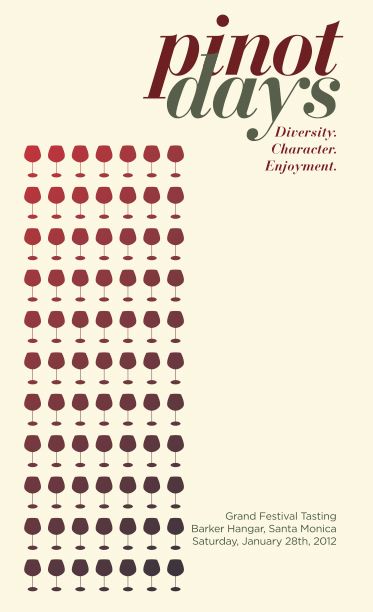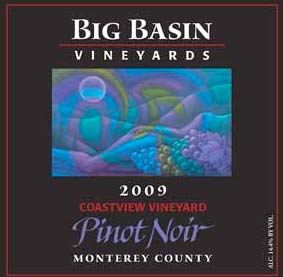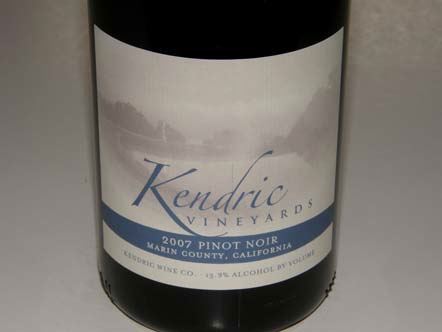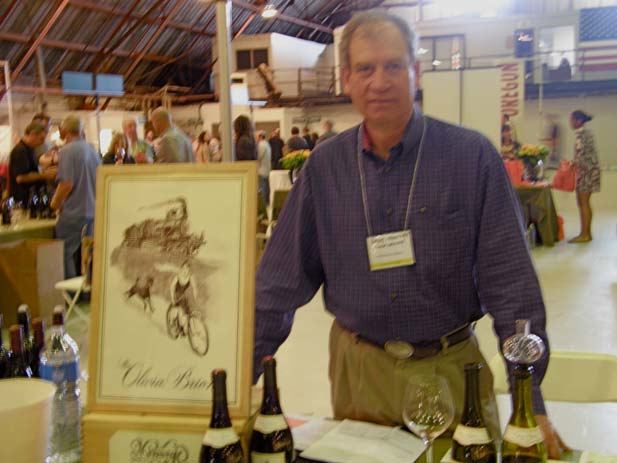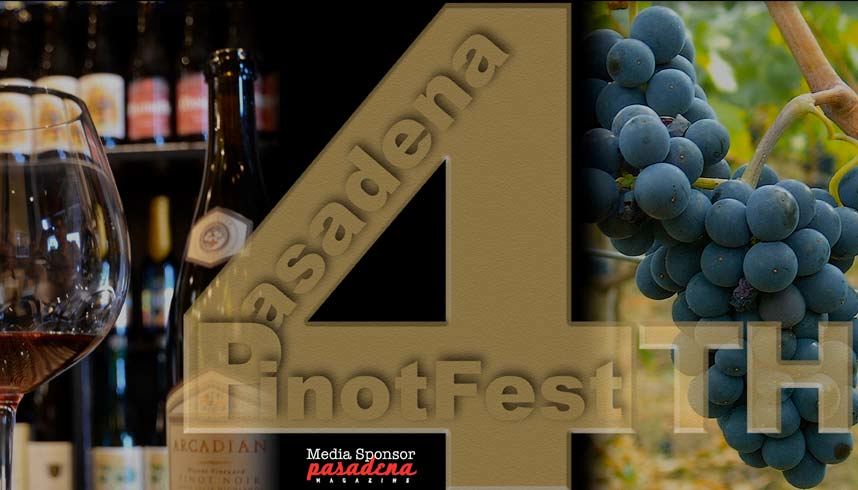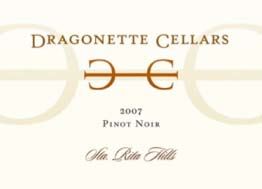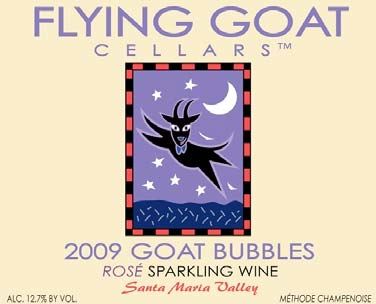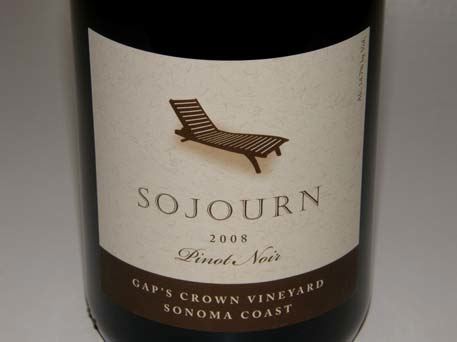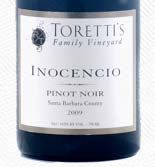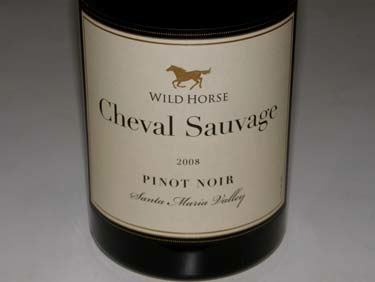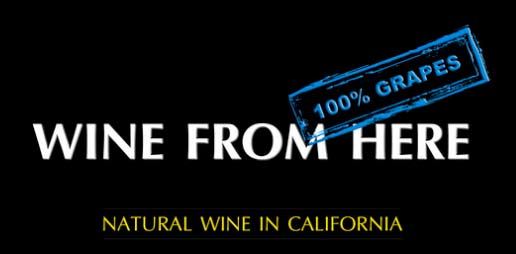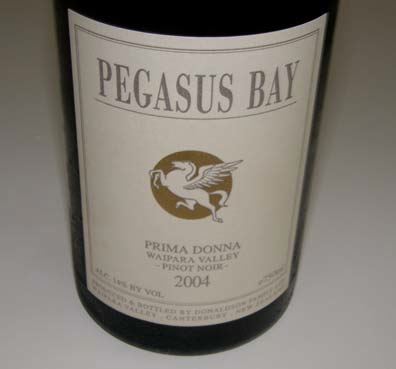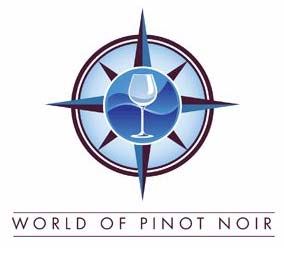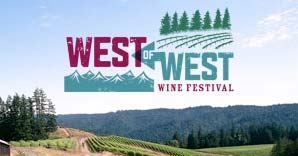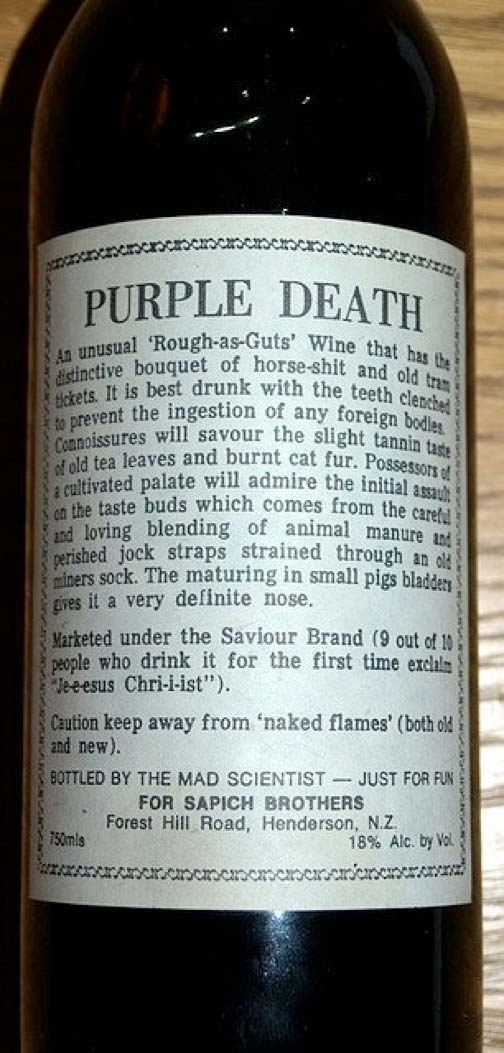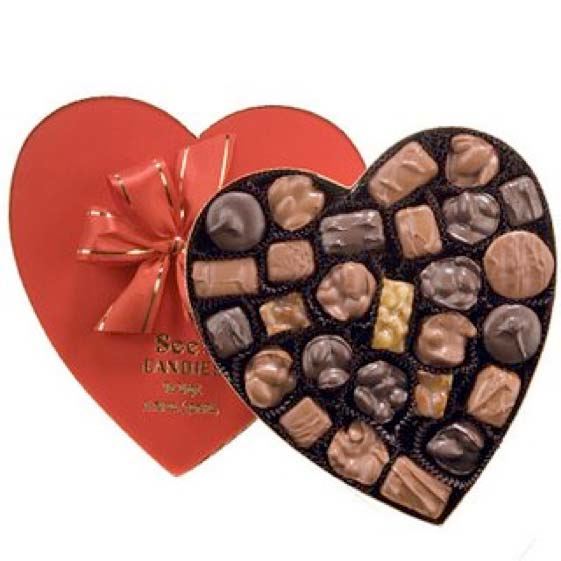PinotFile: 9.3 February 22, 2012
|
Anderson Noir Valley
And in fact it can only grow in these really specific, little, tucked away corners of the world.” ‘Sideways’ movie
Anderson Valley wine producers are relatively isolated, do not have a prominent public marketing campaign, and lack a significant tourist influx due to a paucity of infrastructure, but the Pinot Noir from this bucolic valley is exceptional, perhaps unrivaled by any other Pinot Noir growing region in California. Anderson Valley first achieved validation as a premium grape growing region in the early 1980s when Roederer Estate established extensive plantings of Pinot Noir and Chardonnay and made sparkling wines of the highest caliber. In the last two decades, the region has placed an emphasis on still Pinot Noir. With the cultivation of Pinot Noir clones appropriate for Anderson Valley’s climate coupled with the widespread adoption of modern winemaking and viticulture practices, Anderson Valley producers are now crafting world class Pinot Noir. Many align the region’s style of Pinot Noir more closely with Oregon’s Willamette Valley than California, leading to the offhanded title, “Baja Oregon.” To visit Anderson Valley is to leave the world of roadside McDonalds, Starbucks, and “ampm” stores behind and embrace a pastoral countryside teaming with moss-covered majestic oaks, manzanitas, ramshackle old barns, and grass meadows with calmly grazing sheep and cows. Boonville (population 1,457) is the center of “activity” in the valley with the hamlets of Philo (population 1,098) and Navarro (population 169) nearby to the north.
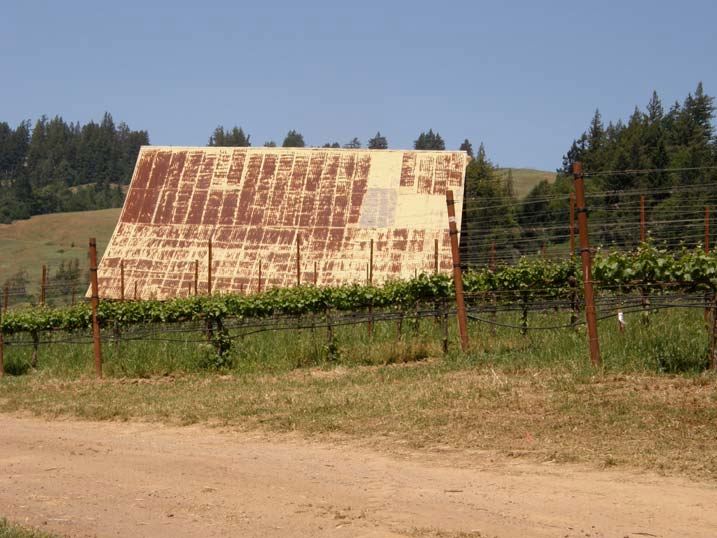 The Anderson Valley is relatively small and narrow, only .5 to 1.5 miles wide and 16 miles long. It is bordered on three sides by 2,000 to 3,000 foot mountains and is 18 miles from the Pacific Ocean at its northern tip which is known by locals as the “deep end.” The valley opens on its northern end to the Pacific coast via the Navarro River Canyon and this unique geography allows fog to roll into the valley in the early morning and gentle, cooling breezes to enter in the afternoon. A gradient is thereby created, with the northern end referred to as “down-valley,” and receiving more rain and fog and therefore cooler, and the southern inland portion, or “upper-valley,” which is typically 8-10ºF warmer. Anderson Valley is classified as a Region I viticulture area in the “down-valley,” and Region II in the “upper-valley” around Boonville. Anderson Valley’s vineyards and wineries are clustered along the fringes of Highway 128, which bisects the valley, with a majority of them located down-valley. Traveling west on Highway 128, you enter the Yorkville Highlands appellation at mile marker 50, the southern border of Mendocino County. At mile marker 33.89 you enter the Anderson Valley appellation. The Mendocino Ridge appellation is along hilltops west of Highway 128. Along Highway 128, the vineyards begin just south of Boonville, continue north through Philo, and end in the tiniest town of the three, Navarro. As Highway 128 continues north, it winds through redwood forests, eventually reaching the town of Mendocino and the Pacific Ocean. The latest map of the Anderson Valley published by the Anderson Valley Winegrowers Association (AVWA, www.avwines.com) is below. An interactive winery map is also available on the AVWA website.
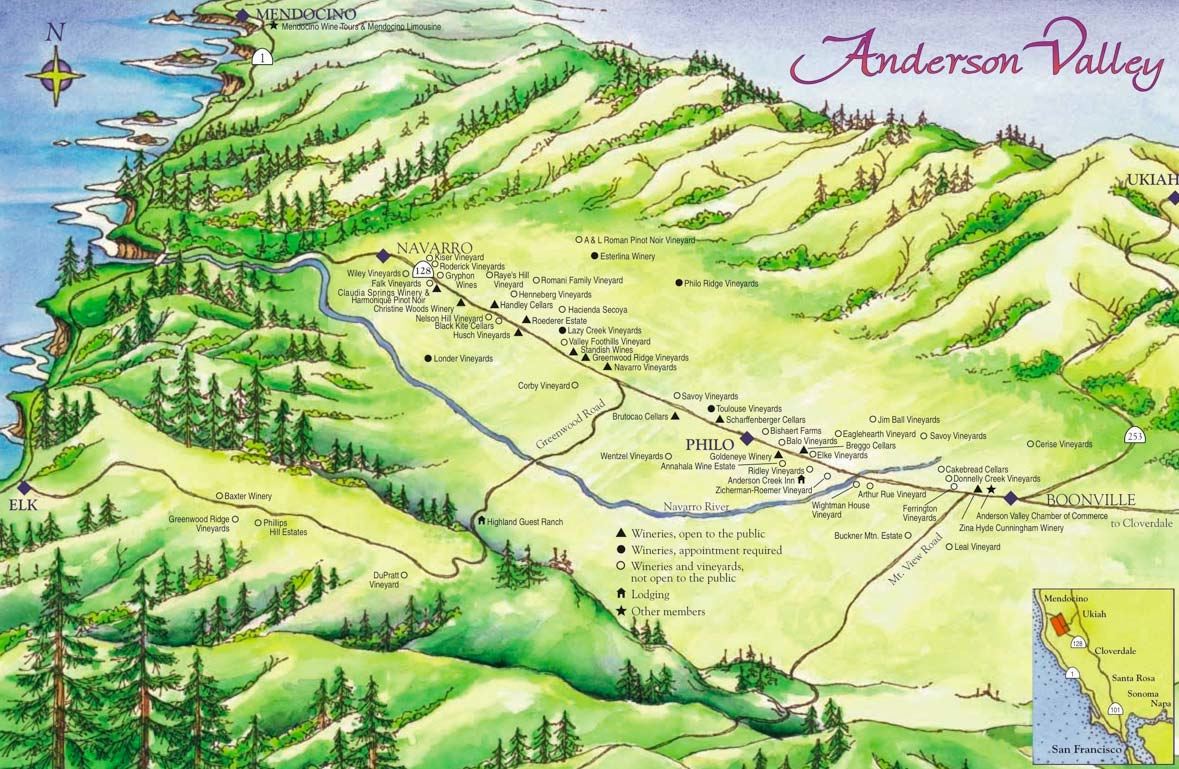 One of the most distinctive features of the Anderson Valley is the unique split rail redwood fences originally built to enclose pastures, but now bordering vineyards along Highway 128. Covered with moss and thoroughly weathered, they conjure an image of the 1800s when farmers in the Anderson Valley took local Pomo Indians into the forests to retrieve redwood for the fences that were an absolute must to protect the crops from the many voracious wild animals that roamed the pasturelands and hills. These crooked fences remain as an enduring reminder of the farming heritage of this picturesque valley.
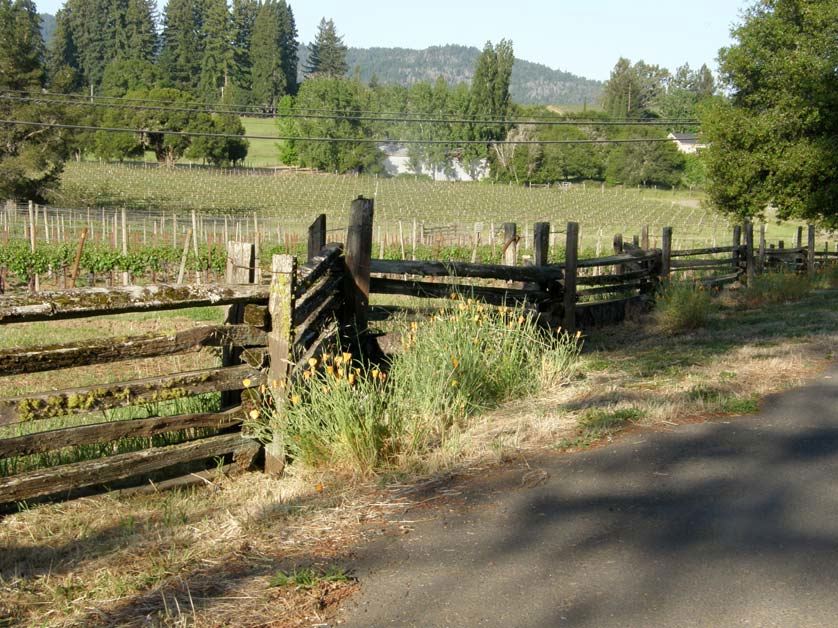 The 2010 census compiled in 2011 reveals the following statistics. There were 85 properties in the Anderson Valley with a median vineyard size of 12 acres and total bearing acreage of 2,244. Pinot Noir accounted for 1,453 acres on 76 properties with lesser amounts of Chardonnay, Gewürztraminer, and other white and red grapes. A large number of vineyards were planted between 1990 and 1999 (1069) and 2000 and 2009 (640). Three large growers, Roederer Estate, Goldeneye and Navarro control the most acreage. The valley’s largest crop in revenue is not grapes, but marijuana.
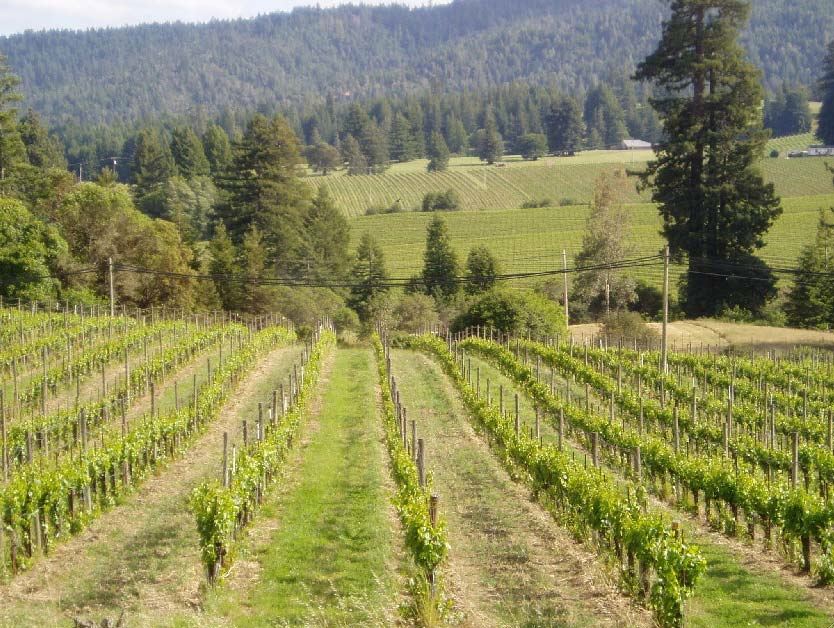 The first Pinot Noir planted in the Anderson Valley was by Wilton (Tony) Husch in 1968. Husch had been exposed to Pinot Noir by John Parducci who was a pioneering winegrower in Mendocino County dating back to 1931. A 3-acre parcel of Husch’s property known as the Knoll was chosen. Located on a hillside overlooking the Navarro River, the Knoll Vineyard was planted to a Wente field selection of Pinot Noir and first harvested in 1971. Long time vineyard manager, Al White, arrived in 1973, two years after Husch Vineyards became a bonded winery. White recounts his first harvest at Husch in 1974, which was archaic by today’s standards. The vines were planted with 8 feet by 12 feet spacing and overhead irrigation was used. Trellising was minimal and no leaf pulling was performed. Rain at harvest was a problem and with it came mold which was a significant nuisance. The grapes were picked into apple boxes at a very casual pace over several days by a hippie crew. The Knoll Vineyard is still producing Pinot Noir, but has been transformed by modern viticultural practices. The Greenwood Ridge Vineyard, located on Mendocino Ridge above Anderson Valley, was planted by Tony Husch in 1972, in an area originally settled by Italian immigrants. Allen Green acquired the vineyard in 1973 and bonded his Greenwood Ridge Winery, a landmark on Highway 128, in 1980. Greenwood Ridge Vineyard has been the site of the California Wine Tasting Championships since 1983. Today, some of Anderson Valley’s Pinot Noir vineyards have become household names to pinophiles including Annahala, Black Kite, Cerise, Charles, Demuth, Donnelly Creek, Ferrington, Goldeneye’s Confluence, The Narrows, Gowan Creek and Split Rail vineyards, Hacienda Secoya, Hein Family, Kiser, Klindt, Londer (pictured below), Maggy Hawk, Monument Tree, Morning Dew Ranch, Roma’s, Roman, Run Dog, Savoy, Toulouse, and Wiley. It is a testament to the high esteem proffered by each of these vineyards that most Pinot Noirs from Anderson Valley are vineyard-designated, with fewer appellation-designated wines produced.
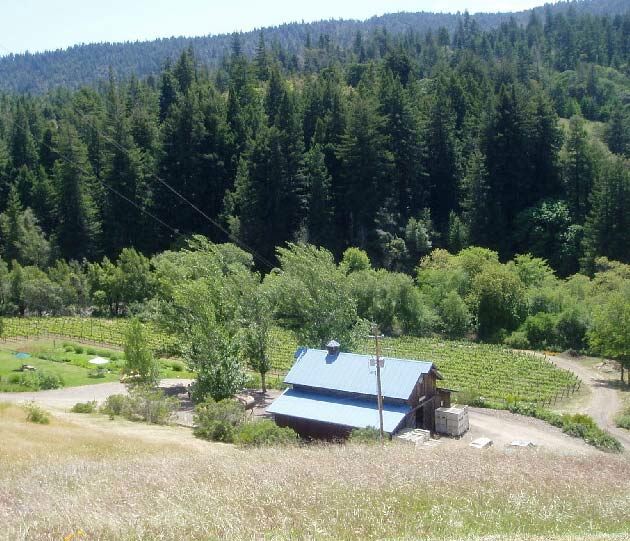 There are 32 wineries in the Anderson Valley with either a winery facility or a tasting room, and at least 37 notable California Pinot Noir producers source grapes from Anderson Valley including 32 Winds, Anthill Farms, Arista Winery, Adrian Fog, Barnett, Benovia, Brogan Cellars, Cakebread Cellars, Chronicle, Copain Wines, Couloir Wines, Ferrari-Carano Vineyards and Winery, Expression Vineyards, Fulcrum Wines, Gryphon Wines, Hartford Family Wines, Harrington, Ici/La Bas, Krutz Family Cellars, Kutch, La Crema Winery, Lioco, Littorai, MacPhail Family Wines, Madrigal Vineyards, Maggy Hawk, Radio-Coteau, Roessler Cellars, Rhys Vineyards, Saintsbury, Skewis, Twomey Cellars, Waits-Mast Family Cellars, Whitcraft, Williams Selyem, Wind Racer and Woodenhead. Do not be deterred from discovering the Anderson Valley by apparent lack of creature comforts. The valley is not about seeking the Napa Valley wine lifestyle. Leave your designer jeans, Louis Vitton handbags and Polo shirts at home. Consider attending the 15th Anderson Valley Pinot Noir Festival May 18-20, 2012. The three day event includes a Technical Conference on Friday, a Grand Tasting with over 40 wineries pouring on Saturday, and winery open houses on Sunday. I attend annually and am easily seduced by the casual country fair atmosphere, the delectable local artisan foods, the warmth and passion of local winegrowers and winemakers, the enthusiastic organizers, and “baul hornin” (that’s boontling, Anderson Valley’s code-like dialect dating to the 1800s, for “good drinking”). Tickets go on sale March 15 and the event quickly sells out each year. Visit www.avwines.com for updates and tickets. Check my website at www.princeofpinot.com and look under “Pinot Trail Travel” on the home page for suggestions on lodging in the Anderson Valley and nearby.
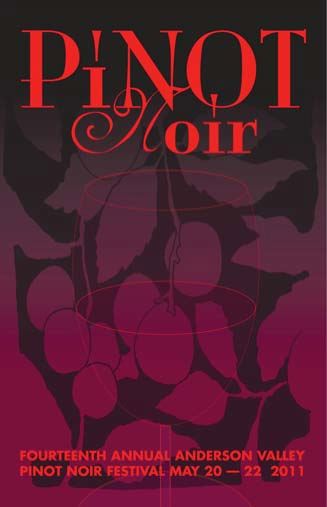 The following Anderson Valley Pinot Noirs were sampled recently. These are impressive wines, offering a very high standard for California. See also reviews of Maggy Hawk, Morning Dew Ranch, and MacPhail Pinot Noir from Anderson Valley in recent issues.
Baxter WineryVeteran winemaker Phil Baxter and his son, Phil, Jr., produce small lots of Anderson Valley and Mendocino County Pinot Noir from a modest winery in the Mendocino Ridge town of Elk. Phil, Jr, was educated in viticulture and enology at University of California at Davis and worked a year in Burgundy at the Domaine de la Vougeraie and Domaine Raymond Launay. The Baxter label was started in 2003, focusing on premium vineyard sources and old world techniques, including the use of little or no new oak elevage for Pinot Noir. The Baxter Pinot Noirs are unique because of the absence of new oak influence on aromas, flavors and tannins. The wines are crunchy, juicy wines with a savory, earthy quality and an elegant bent. Fermentations are whole berry and all natural, punch downs are by hand, and a basket press is used to gently extract the juice. All wines are unfined and unfiltered. The wines should particularly appeal to fans of “natural” wines. Baxter wines are sold through a mailing list and the winery’s online store at www.baxterwinery.com. The winery is open to the public during Open House Day at the Anderson Valley Pinot Noir Festival and at other times by appointment only (707-877-3727).
2009 Baxter Langley Vineyard Anderson Valley Pinot Noir 14.1% alc., $45. This 4-acre vineyard was originally planted in 1982 for sparkling wine but is now used for still wine exclusively. · Moderately light reddish-purple color in the glass. Aromas of dark red cherries and berries, underbrush and paraffin. Pleasingly intense core of cherries wrapped in fine grain tannins and displaying unusually hi-strung acidity, finishing with a flourish of cherry flavor. Elegant and light on its feet. Good.
2009 Baxter Run Dog Vineyard Anderson Valley Pinot Noir 14.7% alc., $45. This 1-acre vineyard is located at the southwestern end of the Anderson Valley and is planted to Pommard clone. · Moderately light reddish-purple hue in the glass. Pleasing aromas of red pie cherries with hints of balsam, nuts and eucalyptus. A juicy wine with tasty dark red cherry and berry flavors complimented by a savory herbal note and subtle spice. The tannins are well-mannered and the wine offers welcoming finesse. Even better the following day from a previously opened and re-corked bottle although showing a little heat on the nose. Very good.
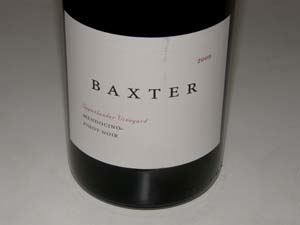 2009 Baxter Oppenlander Vineyard Mendocino Pinot Noir 13.5% alc., $60. · Relatively light reddish-purple color in the glass. The nose is slow to open, revealing an aromatic mix of fresh berries and black cherries which gain appeal and intensity over time in the glass. Medium weight flavors of darker stone fruits and berries with an underlying savory bent, very slight oak in the background, finishing with an hi-tone, slightly tart cherry finish. More austere than other wines I have had from this vineyard, but very appealing for its fruit ripeness, juiciness and ability to pick up intensity and appeal over time in the glass. Very good (+).
DrewJason and Molly Drew founded he Drew label in 2000 while Jason was an associate winemaker at Babcock Vineyards and Winery in the Santa Rita Hills. In 2002 he left Babcock to concentrate on his own label, and in 2004 purchased a 26-acre ridge top property overlooking the Anderson Valley in the Mendocino Ridge appellation. A winery and home were built on the property and a Pinot Noir vineyard has recently been planted. Drew’s new vineyard will be one of the most westerly vineyards on the North Coast. Jason sources his grapes from the Anderson Valley, Sonoma Coast, Mendocino Ridge, and Yorkville Highlands. All the wines are consistently fine and some bottlings can be spectacular. Drew Pinot Noirs are sold on the website, through selected retail channels and at the tasting room at 9000 Hwy 128 in Philo, just northwest of the Goldeneye Winery. The smaller production wines are only sold to the mailing list and Pre-Release Wine Club members. Visit the website at www.drewwines.com.
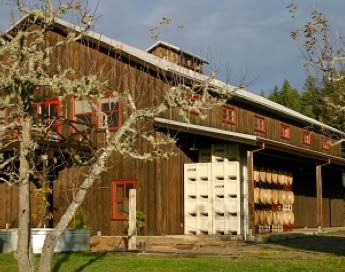
2010 Drew Gatekeepers Anderson Valley Pinot Noir 13.7% alc., pH 3.57, TA 0.64, 242 cases, $28. Sourced from a 30-yearold Pommard 5 block at Wiley Vineyard (55%) and the Akin Vineyard clones 115 and 777 (45%). 40% whole cluster fermented, 55% native fermentation. Aged 11 months in 10% new and 90% seasoned French oak barrels. · Moderately light reddish-purple color in the glass. Aromas of wild berries, cherry glaze and brier picking up some intensity over time in the glass. Lighter weighted flavors of cherries and dried herbs with a hint of oak and a citric peel lift on the finish. An easy drinking wine with a prominent herbal bent which may appeal to some. More fruity and expressive the following day from a previously opened and re-corked bottle. Good.
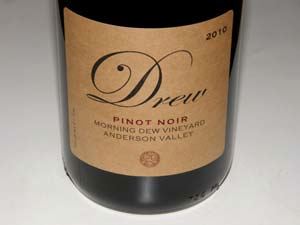 2010 Drew Morning Dew Vineyard Anderson Valley Pinot Noir 13.5% alc., pH 3.55, TA 0.66, 165 cases, $47. Second release from this vineyard. Owner is Burt Williams of Williams Selyem fame. Includes Rochioli selection, a suitcase DRC selection and clone 828. 50% whole cluster fermentation. 50% native fermentation. Aged 11 months in 30% new and 70% seasoned French oak barrels. Unfined and unfiltered. · Moderately light reddish-purple color in the glass. Reserve but pleasing aromas of fresh dark cherries and Pinot Noir must with exotic spice highlights. Delicious core of dark cherries and raspberries with a subtle floral note and complimentary oak features. Very complex, offering different flavor angles with each sip. Lighter weighted and elegant and soft in the mouth with mild tannins and a good cut of acidity on the finish. A world apart.
2009 Drew Fog-Eater Anderson Valley Pinot Noir 13.6% alc., 370 cases, $40. 60% Balo Vineyard and 40% Monument Tree Vineyard. Reviewed in July and August 2011. · Moderate reddish-purple color in the glass. Somewhat brooding on the nose with aromas of riper, darker fruits and leather. Tasty array of fruit on the palate including black cherries and dark red berries with hints of tea leaves and herbs in the background. Mild tannins. Good.
Foursight WinesBill and Nancy Charles, long time winegrowers in the Anderson Valley, teamed with daughter Kristy Charles and her winemaker spouse Joseph Webb to launch Foresight Wines in 2007. Webb learned his winemaking at Sebastiani, Landmark Vineyards and Joseph Swan Vineyards. The estate Charles Vineyard near Boonville was planted to Pinot Noir, Sauvignon Blanc and Semillon in 2001. The Pinot Noirs have been impressive from the start, not surprising when you consider Foursight has the formula for great artisan Pinot Noir in place: warm people, stellar estate vineyard fruit, and a bright, talented young winemaker. Like Baxter, Foursight also releases a “Zero New Oak” Charles Vineyard Pinot Noir, the first dating to the 2007 vintage. In addition, two Pinot Noirs aged traditionally in some new oak are offered each year. The wines offer an opportunity to experience the influence of new oak on Pinot Noir. All three are all well-crafted, displaying modest alcohols yet fully ripe flavors. The 2009s are the best wines to date from this vineyard and although approachable now, they will benefit from further time in the bottle.
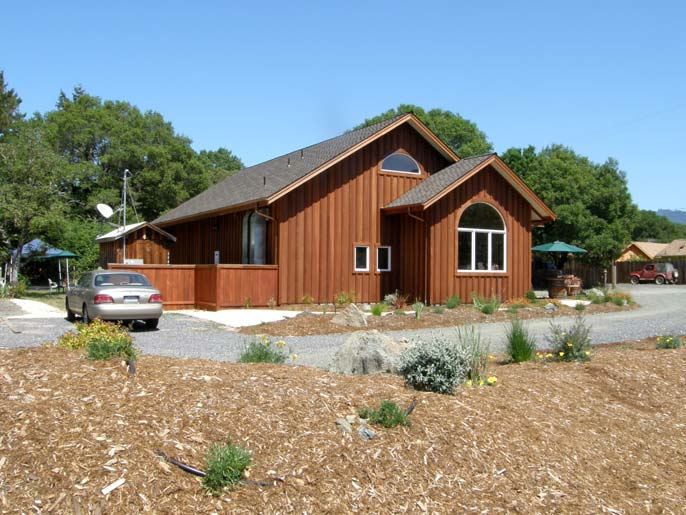 A tasting room and winery opened in 2009 on Highway 128 in Boonville. The structure was designed and built by Bill Charles from lumber grown, harvested and milled on the Charles family ranch.
2009 Foursight Wines “Zero New Oak” Anderson Valley Pinot Noir 13.5% alc., pH 3.48, TA 0.64, 360 cases, $38. Released fall 2011. Aged in 2-year-old French oak barrels. 30% whole cluster, wild fermentations. · Moderate reddish-purple color in the glass. Very fruity nose featuring black cherries. Crisp and juicy black cherry and cranberry flavors with a hint of spice. Mild, soft tannins and smooth in the mouth. Lacks a little mid palate richness, structure and finishing persistence of a typical oaked Pinot Noir but has its own charm in the purity of its unplugged fruit flavor. Very good (-).
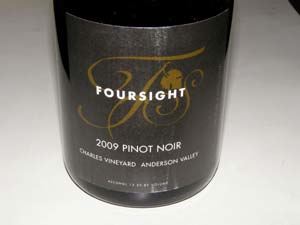 2009 Foursight Wines Charles Vineyard Anderson Valley Pinot Noir 13.5% alc., pH 3.48, TA 0.63, 405 cases, $46. Released fall 2011. Clones 777, 114, 115 and Pommard 5. 30% whole cluster. Wild fermentations. Aged in 15% new, 57% 2-year-old, 14% 3-year-old, and 14% neutral French oak barrels. · Moderate reddish-purple color in the glass. Intensely fruity on the nose featuring aromas of dark red berries and black cherries with the slightest spice, leather and oak. Picks up interest over time in the glass. Fills the mouth with broad flavors of red and black stone and berry fruits with complimentary oak-driven notes of toffee and cola in the background. Modest tannins with inviting crispness and a good cut of acidity on the finish. Flat-out great later in the day from a previously opened and re-corked bottle. I like this wine for its presence without pronounced weight.
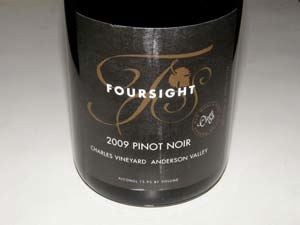 2009 Foursight Wines Charles Vineyard “Clone 05” Anderson Valley Pinot Noir 13.9% alc., pH 3.58, TA 0.61, 69 cases, $49. Released fall 2011. Aged in 50% new, 25% 2-year-old, and 25% neutral French oak barrels. 100% Pommard clone. 30% whole cluster, wild fermentations. · Moderate reddish-purple hue in the glass. Earthy, savory, and succulent dark fruits on the nose and palate with a complimentary hint of spice, and a lingering subtle note of refreshing citrus on the very long finish. Quite distinct from the Charles Vineyard blend bottling in that it is richer, slightly denser, more assertive on the mid palate, and is structurally more firm, yet the tannins are perfectly proportioned. A beguiling expression of Pommard clone that really shines the next day from a previously opened and re-corked bottle.
LittoraiNoted winemaker Ted Lemon crafts exquisite Pinot Noirs from Anderson Valley vineyards that he personally oversees with great care. Lemon was the first to create a “by-the-acre” contract for grapes in which he closely supervised all aspects of vineyard management including pruning, fertilizing, irrigation and crop yields. This type of contract allows growers to be paid for the quality of what they grow, not the quantity. The first contract was written in 1993 for the One Acre Vineyard in the Anderson Valley that is part of Rich Savoy’s Deer Meadow Ranch. This type of contract is now the norm for premium Pinot Noir growers in California and Oregon. Lemon’s vineyard sources are almost entirely farmed organically and biodynamically. Lemon has an exceptional record of terroir-based winemaking in California. His winegrowing and winemaking idiom is profoundly Burgundian since he learned from such eminent winemakers as Jacques Seysses, Aubert de Villaine, and Jean Marie Roumier. His years in France inspired him to base his winemaking philosophy on terroir. Terroir-based winemaking postulates that wine from a single place produced by a single estate is the greatest expression of winemaking. Lemon’s winemaking approach emphasizes minimal intervention, long lees contact and gentle handling of the fruit and wine. Pumps and filtration are avoided. The Pinot Noirs are fermented in traditional open-top fermenters and at least some proportion of whole clusters are used. All wines undergo native yeast fermentation and complete natural malolactic fermentation, as long as nature does not dictate otherwise. His goal is to avoid high alcohol levels and over ripe flavors, with a focus on finesse, balance and length. Usually 33% to 50% new oak is used for aging as an element of complexity, but never lead you to think of oak when tasting a Littorai wine. The objective at Littorai is wines of harmony that can improve and blossom with cellaring. One lesson I have learned from tasting many Littorai wines over the years is that they often do not sparkle when young, but assume complexity and interest over time, often reaching their peak in six to eight years and carrying on for a number of years beyond. I have run into a number of tasters who were not impressed when tasting the wines that had been recently bottled, but I always assure them that over time their patience will be rewarded. Alcohol levels are relatively low in 2009. The power in the wines comes from their structure and acidity, not flamboyant ripe fruit. Besides the vineyards below, Littorai accesses fruit from Roman Vineyard, Cerise Vineyard, and Wendling Vineyard in the Anderson Valley. A blend of Anderson Valley fruit, Les Larmes, is produced annually and in 2010 contains declassified One Acre fruit. In the 2011 vintage, an Anderson Valley Vin Gris from Savoy Vineyard is offered which is available now (picked at 20.5 degrees Brix, and a finished alcohol of 12.5%). Littorai winery is located on Ted and Heidi Lemon’s biodynamic farm in Sebastopol. Visitors are received for tours and tasting by appointment (707-823-9586). Littorai wines are sold exclusively to a mailing list at www.littorai.com (the recently updated website is quite an improvement!). Littorai is a favorite of sommeliers and as a result many top restaurants tout Littorai wines on their wine lists.
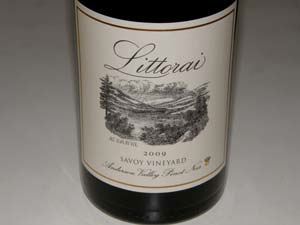 2009 Littorai Savoy Vineyard Anderson Valley Pinot Noir 13.4% alc., $60. · Moderately light reddish-purple color in the glass. Slow to open, offering demure scents of black cherries and black raspberries with notes of brier, leaf and oak char. The mildly sweet core of fruit is clearly very classy but is immersed at present in tannin and oak. The tannins, however, are not oak-driven or astringent and should meld nicely over time. The wine’s hi-pitched acidity offers a very juicy, mouthwatering finish. Like many Littorai wines, it needs some cellaring and offers plenty of upside potential. Very good (+)
2009 Littorai One Acre Vineyard Anderson Valley Pinot Noir 13.3% alc., $75. Replanted in 2005. · Medium reddish-purple color in the glass. Aromas of red berry tart, wet leaves, hay bale, spice and a floral note. Prudent concentration of fresh, dark red berries and cherries backed by ripe fruit tannins and underlain with oak-driven flavors. Notable persistence on the silky finish. Impeccable balance. Cellar for another 2-3 years. Very good (-).
2007 Littorai Savoy Vineyard Anderson Valley Pinot Noir 13.5% alc., $60. · Light reddish-purple color in the glass. The nose is closed for business initially, opening slowly in the glass to reveal scents of dark red berry fruit and spice. Relatively light in heft featuring flavorful red pie cherries. Prominent tannins tend to overwhelm the delicate fruit at this stage. Bright acidity and a silky mouth feel. About the same the following day from an opened and re-corked bottle, still showing aggressive tannins. Just doesn’t have a crescendo now and should be aged at least another 2-3 years. Not up to the level of two previous tastings of this wine. Good.
Navarro VineyardsTed Bennett and Deborah Cahn were among the first wave of pioneers to establish vines in the Anderson Valley, acquiring a 900-acre sheep ranch along Highway 128 between Philo and Navarro in 1973. Since they were Alsatian grape aficionados, they initially planted only white varietals. Pinot Noir came later and today they are one of the three largest holders of Pinot Noir acreage in Anderson Valley. It was largely their marketing sense that put Anderson Valley in the minds of wine enthusiasts and brought notoriety to the wines of the region. They built an attractive tasting room and sent out a very informative newsletter that led to significant consumer-direct sales and buyer loyalty. The next generation, Aaron and Sarah Cahn Bennett, are now actively involved in the winery. Winemaker Jim Klein has been at Navarro since 1992. Three Pinot Noirs are produced: a Mendocino blend, a Méthode A L’Ancienne Anderson Valley Pinot Noir (from Navarro’s estate fruit and a small amount of grapes from other growers in the Anderson Valley), and a Deep End Blend Anderson Valley Pinot Noir (a reserve made exclusively from higher elevated sites and the most age worthy). Navarro has made consistently fine Pinot Noir for many years, and is one of the most underrated sources of top-shelf, yet reasonably priced, Pinot Noir in California. Navarro is also a leading producer of Alsatian-style white wines, Chardonnay, Sauvignon Blanc and Zinfandel. Grapes are night harvested and de-stemmed into small bins. Wild yeast fermentations are encouraged. For three decades, Navarro has fertilized the vines with compost generated from winery waste, so the vineyards are densely populated with many strains of yeast. All three wines reviewed below are sleek, refined and beautifully balanced. They can be enjoyed now. Navarro wines are sold through the tasting room which is open daily and a mailing list that receives a very informative newsletter. The website is www.navarrowines.com. Magnums are available. Interestingly, Babydoll Southdown lambs have been raised on the Navarro property for over one hundred years. This relatively rare breed is used to eat the cover crop in Navarro’s vineyards, which cuts down on tractor use and the resulting depletion of fossil fuels. The Babydoll lambs are short in stature which keeps them from eating the grapes. You can visit the website and view the barnyard and the latest lambs to be born with the Navarro Lamb Cam.
2006 Navarro Méthode A L’Ancienne Anderson Valley Pinot Noir 13.7% alc., $29. · Moderately light reddish-purple color in the glass. Appealing bright aromas of black cherries, berry jam on brioche and a hint of vanilla. Seamless on the palate with a delicious core of cherries, a complimentary hint of anise and oak, mild tannins, and a finishing charge of cherries jubilee. Impeccable balance.
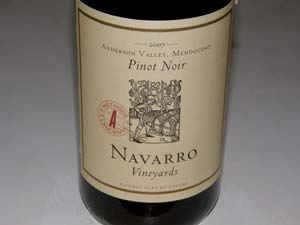 2007 Navarro Méthode A L’Ancienne Anderson Valley Pinot Noir 13.8% alc., $29. · Moderate reddish-purple robe in the glass. Similar to the 2006 vintage but has its own style with a little more structure and darker fruits. Black cherries are the theme with perfect integration of toasty oak. Finishes with a lingering aromatic intensity that aims to please. Outstanding.
2009 Navarro Méthode A L’Ancienne Anderson Valley Pinot Noir 14.2% alc., pH 3.68, TA 0.67, 4,910 cases, $29. · Medium reddish-purple color in the glass. Demure, but pleasing aromas of black raspberries and boysenberries with a hint of brier and oak. Fresh and uplifting on the palate with a darker berry and black cherry flavor profile. Medium-weighted with well-behaved tannins and bright acidity. Admirable balance predicts longevity.
Wind Racer WinesBarbara Banke, a former lawyer and wine connoisseur who married Jess Jackson and played a major role in the growth of Jackson Family Wines, teamed with Peggy Furth, the former co-proprietor of Chalk Hill Estates & Vineyards to launch the Wind Racer brand of Anderson Valley and Russian River Valley Pinot Noir and Chardonnay. Banke loves the precision and focus of Anderson Valley Pinot Noir and Chardonnay and Furth prefers the opulence and exotic aromas of their Russian River Valley counterparts. The wines are highly allocated with the only source I am aware of being Sherry-Lehman in New York. Visit www.windracerwines.com for more information.
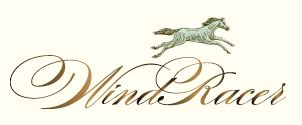
2007 Wind Racer Anderson Valley Pinot Noir 14.7% alc., $49. · Medium reddish-purple color in the glass. Highly perfumed with aromas of black cherries, strawberries and sandalwood. Flavors of cherry, strawberry and rhubarb pie with a hint of mocha and cola in the background which enhance the appeal. Very lovely fruit with a delicate, but persistent oak-tinged finish. Soft and silky in the mouth and quite charming. More Russian River Valley than Anderson Valley in character due to the degree of ripeness and flavor profile. Very good.
2007 Wind Racer Russian River Valley Pinot Noir 14.5% alc., $49. · Moderate reddish-purple color in the glass. Pleasant, but demure, aromas of black cherries and subtle oak becoming more fruity over time in the glass. Medium weight flavor of cherry tart with supporting oak. The wine has a silky richness that Russian River Valley Pinot Noir is known for. The tannins are restrained, the whole package is nicely balanced and the wine is very drinkable now. Very good.
More Anderson Valley Pinot Noir
2009 Breggo Anderson Valley Pinot Noir 14.8% alc., pH 3.68, TA 0.55, 2,183 cases, $38. Released April 1, 2011. A blend of numerous clones from Donnelly Creek, Savoy and Wiley vineyards. Aged 10 months in 44% new French oak barrels. · Moderately light reddish-purple color in the glass. Aromas of dark red cherries and berries, tea leaf, wet leaf and brier. Middleweight flavors of dark red fruits with an undertone of dried herbs, stem and earth. Decent (+).
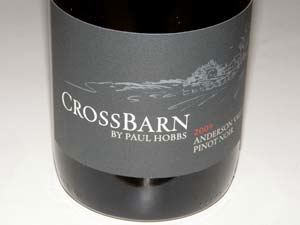 2009 Crossbarn by Paul Hobbs Anderson Valley Pinot Noir 14.7% alc., $35. A blend of vineyards. 14 day total maceration. Aged 12 months in 23% new French oak barrels. Unfined and unfiltered. · Moderate reddish-purple hue in the glass. Perfume of plum sauce, dark berry jam and seasoned oak. Veers to the riper fruit flavor spectrum with tastes of plum, blackberrry and ollaliberrry. Full-bodied, smoothly textured and endowed with a firm tannic structure. The fruit is quite luscious and will find many fans. Good (+).
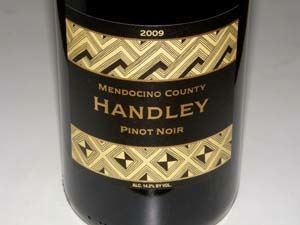 2009 Handley Mendocino County Pinot Noir 14.2% alc., $25. 50% from Anderson Valley, both warmer Boonville end and cooler deep end, and 50% from Potter Valley. · Moderately light reddishpurple color in the glass. The aromatics jump out when the cork is removed, showing bright and pleasing scents of fresh black cherries, strawberries, sandalwood and dried fruit. Juicy and easy to drink, with tasty flavors of dark red cherries and berries, spice, pine needles, and cherry cola, all wrapped in very supple tannins. An unexpected surprise for an entry level wine that really satisfies. Very good.
2009 Migration Anderson Valley Pinot Noir 14.5% alc., pH 4.00, TA 0.49, $34. Aged 10 months in 45% new and 55% second vintage French oak barrels. · Moderate reddish-purple color in the glass. The nose is dominated by toasted oak with faint dark fruit in the background. Medium bodied array of dark red berries with prominent oak-driven tarry flavor. Soft and slightly creamy on the palate. Decent.
Mining the Pinot Bargain Bin: It’s What’s for Dinner
2009 Benton Lane Estate Grown Willamette Valley Pinot Noir 13.55% alc., $20, screw cap. · Moderately light reddish-purple color in the glass. Complex aromatic profile offering scents of dark red cherries, ripe raspberries, oak, tobacco and freshly tilled earth. A light to medium weight offering with savory flavors of dark red cherries and berries. A basic Pinot Noir that is reasonably refined with soft tannins and complimentary oak. Decent (+)
2009 Cameron Hughes Lot 276 Los Carneros Pinot Noir 14.2% alc., $11. · Moderately dark reddish-purple color in the glass. With vigorous swirling, aromas of dark plums, black currants and raisin emerge. Very ripe in character featuring plum and blackberry flavors with a vein of oak and spice. Restrained tannins and very approachable. Available at Costco. Good (-).
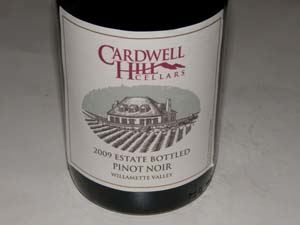 2009 Cardwell Hill Cellars Estate Bottled Willamette Valley Pinot Noir 13.2% alc., $22. Clones are Wädenswil, Pommard, Dijon 115 and 777. Aged 10 months in French oak barrels. · Moderately light reddish-purple color in the glass. Reserved aromas of cherries with musty oak, becoming livelier the next day from a previously opened and re-corked bottle. Flavors of red cherries and berries sprinkled with herbs, offering a slight tartness on the frisky finish. Good.
2010 Coelho Winery Atracão Willamette Valley Oregon Pinot Noir 13.2% alc., $20. Atracão translates as “behold the attraction.” · Moderately light reddish-purple color in the glass. Pure and effusive aromas of cherries with a slight scent of herbal oak and straw. Crisp and bright, light in weight, with a core of red cherry flavor, finishing with a tug of herbal oak. Decent.
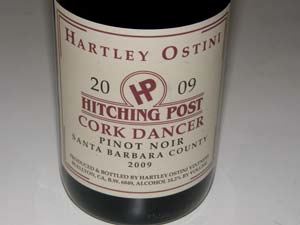 2009 Hitching Post Cork Dancer Santa Barbara County Pinot Noir 14.2% alc., $18, screw cap. The duo of Hartley and Ostini have been making wine since 1979. The Hitching Post tasting room is at the Hitching Post II Restaurant in Solvang. · Moderate reddish-purple color in the glass. Very nice perfume of pie cherries, spice and oak. More complex than you would expect at this price level with flavors of dark red berries and cherries, rose hips tea and cola, with a hint of citrus peel on the uplifting finish. Well-managed oak and tannins with an easy drinking personality. Would work beautifully with a Hitching Post oak-grilled steak. Very good.
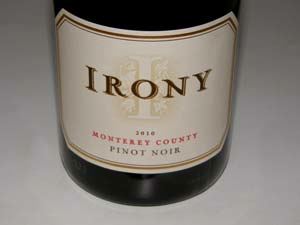 2010 Irony Monterey County Pinot Noir 13.5% alc., $10-$12. · Moderate color trending toward purple in the glass. Enticing aroma of dark berry jam with a hint of oak. Very tasty core of blackberries, boysenberries and fruit leather with a complimentary underpinning of oak. A very charming wine with a rich mouth feel and impressive finishing strength and length. Still excellent the next day from a previously opened and re-corked bottle. Very good.
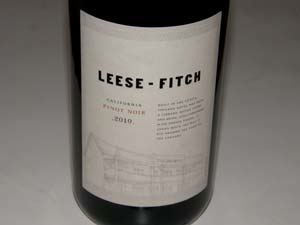 2010 Leese-Fitch California Pinot Noir 13.5% alc., $8-$10, Zork closure. The biggest selling Pinot Noir fromThe Other Guys, Napa, CA. The Leese-Fitch wines celebrate the restoration of the historic Leese-Fitch Adobe on Sonoma Plaza which was built in 1836 and was named after Jacob Leese and Henry Fitch, brothers-in-law to General Mariano Vallejo, the founder of the town of Sonoma. Sourced from Santa Barbara County and Clarksburg. Previous vintages contained a small percentage of other red varieties. · Moderately light reddish-purple color in the glass. Aromas of dark berries, plums, dried herbs and wet leaves. Tasty core of black raspberry fruit with added interest from notes of black grapes, dark cherries and cola. Lighter weighted with bright acidity and moderate tannins, silky on the palate, with a hint of toasted oak and mocha in the background. Good (+).
2010 Mark West California Pinot Noir 13.8% alc. $10. From primarily Central Coast appellations. Fermented in small lots with daily punch downs, lightly pressed, aged in French and Hungarian oak barrels for about 8 months. · Moderately light reddish-purple color in the glass. Aromas of black cherries, oak and dried herbs, fading in fruit expression over time in the glass. Core of middleweight black cherry fruit with plenty of oak flavors such as tobacco and toffee in the background. Juicy with mild tannins and up front drink ability with a silky texture. Becomes less desirable over time in the glass. May improve over the next 6 months as the oak more fully integrates. Decent.
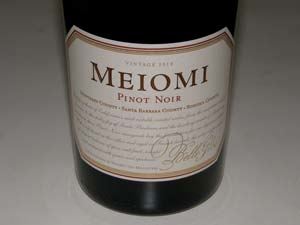 13.8% alc., $18-$20, screw cap. “May-OHmee” means “Coast” in the language of the California Wappo Indian tribe. 57% Monterey County, 23% Santa Barbara County, and 20% Sonoma County. Winemaker Joseph J. Wagner. · Moderately dark reddish-purple color in the glass. Deep, rich and enticing aromas of plums and dark berries with a hint of oak spice, vanillin and BBQ. Discreetly concentrated, yet richly flavored with delicious plum, black raspberry, dark chocolate and vanilla cola notes. The fruit is caressed by soft, fine-grain tannins, creating a velvety mouth feel that is very seductive. The best Meiomi Pinot Noir to date. This wine will find many fans. Widespread retail and restaurant availability. Very good. Note: At the recent Pinot Days Southern California, Meiomi had two very attractive young women in hot pants and boots roaming the event promoting Meiomi Pinot Noir. This is the first time I have seen this marketing approach at a Pinot Noir event. Obviously aimed at Millenials (although they approached an old duck fart like me), this is surely a sign of the future of wine promotion.
2009 Moobuz Monterey Pinot Noir 13.9% alc., $15, Zork closure. From The Other Guys. · Moderately light reddish-purple color in the glass. Aromas of black cherries, black raspberries, spice, oak char and sweet smoke. The flavors echo the nose. Moderately light with mild dusty tannins and a good snap of acidity on the finish. The undertone of smoky oak detracts. Decent.
2010 Pali Wine Co. “Huntington” Santa Barbara County Pinot Noir 14.6% alc., 2,136 cases, $21. A multiple vineyard blend. Aged 10 months in 30% new French oak barrels. · Moderate reddish-purple color in the glass. Aromas of black plum reduction sauce, Asian 5-spice, and a leafy green note from oak. Medium weight flavors of dark berries and plums with the slightest oak in the background. Nothing complicated, but a solid wine with mild sandy tannins and decent acidity that is friendly and satisfying. Good (+).
2010 Pali Wine Co. "Bluffs" Russian River Valley Pinot Noir 15.3% alc., 2,274 cases, $21. Sourced from several vineyards. Aged 10 months in 30% new French oak barrels. · Medium reddish-purple color in the glass. Nicely perfumed with aromas of Bing cherries, spice and sandalwood. Tasty core of slightly sweet black cherry fruit with a riff of cola and dark chocolate in the background. Rich and intense and flush with fruit that the Russian River Valley would be proud of. Texturally smooth, finishing with some firm tannins. Good (+).
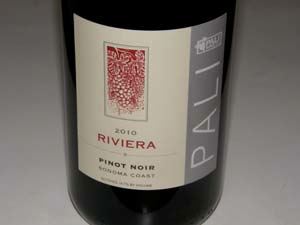 2010 Pali Wine Co. “Riviera” Sonoma Coast Pinot Noir 14.7% alc., 10,500 cases, $20. Sourced from several unnamed vineyards. Aged 10 months in 30% new French oak barrels. · Moderate reddish-purple hue in the glass. Fruity nose displaying aromas of cherries, raspberries, blueberries and grape juice with a hint of oak and spice. Dark fruited and medium weighted with an interesting feral quality and grilled fruit undertone. The wine is well crafted with pleasing balance and easy drink ability. Good (+).
2010 Pali Wine Co. “Alphabets” Willamette Valley Pinot Noir 13.5% alc., 1,700 cases, $20. Aged 10 months in 30% new French oak barrels. · Moderately dark reddish-purple color in the glass. Largely devoid of fruit on the nose, displaying aromas of underbrush, straw and woodpile. Medium weight dark red fruit flavors with a grassy, green tomato bent that I do not find appealing and may represent under ripe fruit. Decent at best.
2010 Pali Wine Co. "Summit'" Sta. Rita Hills Pinot Noir 15.5% alc., 210 cases, $29. Sourced from an unnamed prominent vineyard. Aged 10 months in French oak barrels. · Very darkly colored and dense in the glass. Aromas of spiced black plums, blackberries, raisin and mulled wine with subtle oak char in the background. A big gulp of fruit: rich, dense and concentrated bordering on jammy with a hint of anise, iron and oak. Very smoothly textured on the palate with a moderate tannic backbone. Too ripe, too big, too alcoholic (slightly hot on the finish), and a bit tiring to drink over time, but the fruit flavor is undeniably appealing. Decent.
Note: The same day I tasted the Pali Wine Co. Summit, an article appeared in the Los Angeles Times (“Cool Trend,” by Patrick Comiskey, February 9, 2012) discussing how a number of highly visible winemakers in the Santa Rita Hills are returning to “natural elegance,” in the style of their Pinot Noirs and Chardonnays. The trend is toward avoiding the push to extreme ripeness, high alcohols and deeply flavored wines with fruit-bomb character. The article ends with a quote by Richard Sanford: “In the end, elegance is more important than impact.” It is clear from the Summit Pinot Noir that the winery has not bought into this trend and believes there is still a significant market for big, ripe, extracted Pinot Noir from the Santa Rita Hills. With wine, and particularly Pinot Noir, there is no one style that dictates every consumer’s preference.
2010 Pennywise California Pinot Noir 13.6% alc., pH 3.64, TA 0.58, 27,000 cases, $12. · Moderately light reddish-purple color in the glass. Complex nose offering aromas of black cherries, brier, chalk and oak. Discreetly concentrated core of dark cherry and dark red berry fruit with supporting oak. Smooth on the palate with well-hued tannins and easy drink ability. Good (-).
2010 Sean Minor Four Bears Central Coast Pinot Noir 13.5% alc., $12, screw cap. · Moderate reddish-purple hue in the glass. Darker fruits are featured with added aromas of kitchen spice, oak and cut flowers. Very soft on the palate with a tasty array of dark red cherry, black raspberry and blueberry flavors enhanced by a touch of oak. Moderately light and easy to drink with commendable tannic support. Lacks finishing strength but otherwise is quite impressive at this price level. Good (+).
Hirsch Vineyards: Seismic PinotDavid Hirsch was a visionary who planted one of the first vineyards in the true or West Sonoma Coast in Cazadero, which lies in the new Fort Ross/Seaview appellation. In 1978, Hirsch purchased 1,100 acres on a remote ridge 900 feet above the Pacific Ocean at the end of Bohan-Dillon Road. Beginning in 1980, he began the first two-acre planting of what eventually would encompass 68 acres of Pinot Noir and 4 acres of Chardonnay on ridge tops above the fog line a few miles inland from the Pacific Ocean. The vineyard became world-renowned when Burt Williams (Williams Selyem), Ted Lemon (Littorai), and Steve Kistler (Kistler) showed up one day in the early 1990s, chose their blocks, and started making exceedingly good and age worthy vineyard-designate Pinot Noir from the Hirsch Vineyard. The name, Hirsch Vineyard, quickly became synonymous with the true Sonoma Coast as Hirsch’s vision gathered increasing validation with the arrival of many other prominent Pinot Noir producers who followed his lead.
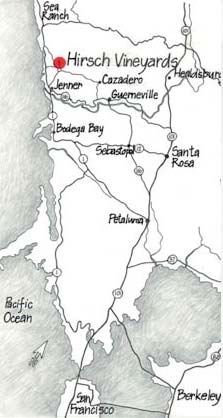 The Cazadero area is a coastal rainforest (rainfall averages eighty inches annually) with a desert-like climate in the summer. The climate is very unpredictable, with wide swings in temperature, wind and storms. The vineyard is scattered over several ridge tops with varying exposure, altitude and soil type (mainly sandstone-based), and there are a variety of rootstocks and clones (114, 777, Pommard, Swan and Mt. Eden) planted. The Pinot Noir plantings are divided into old vineyards (planted between 1980 and 1998) and new vineyards (planted in 2002 and 2003, with some replanting in 2007 due to phylloxera). The result is considerable heterogeneity to the fruit, so Hirsch Vineyard Pinot Noirs from different producers are difficult to compare. Chardonnay planting started in 1994 with cuttings from Joe Rochioli. Additional plantings ensued in 2002. The first estate Chardonnay was produced in 2006. Refer to the Hirsch Vineyards website at www.hirschvineyards.com for a precise delineation of all the vineyard blocks at Hirsch Vineyards. The photograph below was taken over the Hirsch Vineyard and demonstrates the varied topography. The ridge formations are a prime result of the San Andreas seismic fault that lies between Hirsch Vineyards and the Pacific Ocean with the fault influencing the climate as well. Beginning with the 2007 vintage, Hirsch Vineyards Estate Pinot Noir is labeled “San Andreas Fault” to emphasize the importance of this seismic fault in the character of Hirsch Vineyards wines.
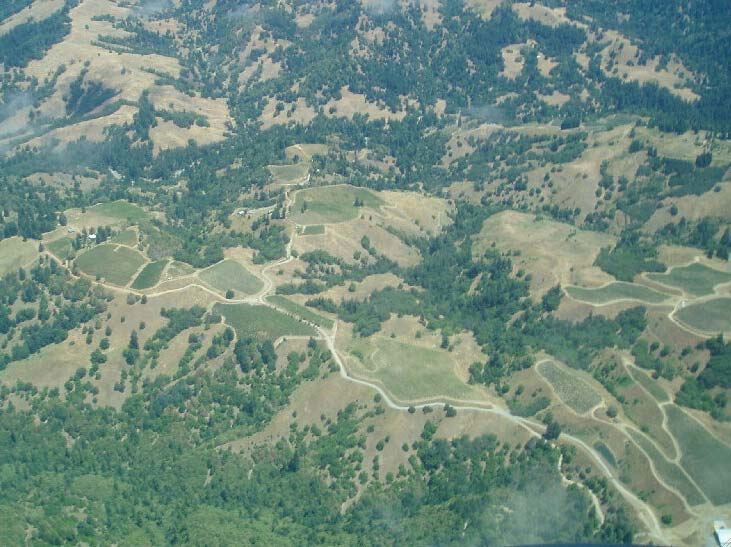 In 2002, Hirsch built a 15,000-case winery on the estate in an old lambing barn, and brought in winemaker Vanessa Wong (now the winemaker at Peay Vineyards) to craft the first Hirsch Estate Pinot Noir (vintage 2002). She vinified two vintages and was replaced by Mark Doherty (formerly of PlumpJack and Davis Bynum), who crafted the 2004 - 2009 vintages. He left in December 2009, replaced by Ross Cobb (also of Cobb Wines). Cobb blended the 2009 wines and 2010 was the first vintage he crafted from beginning to end at Hirsch. Since Cobb worked with Hirsch grapes while making wine at Williams Selyem and Flowers he is considered a total denizen of the Hirsch property. Current production of Hirsch Vineyards Pinot Noir and Chardonnay is about 5,500 cases annually. Grapes are sold to many prominent California wineries including Faille, Lioco, Littorai, Siduri and Williams Selyem. Everado Robledo has been the Hirsch Vineyards’ vineyard manager since 1988. He first grafted two acres of Riesling over to Mount Eden clone of Pinot Noir on the Hirsch property and never left. He lives on the site and planted all 90,000 vines on the 72 acres of Hirsch Vineyards. He is one of eight Robledo brothers who have played an important role in the development of vineyards and wineries in both Napa and Sonoma counties. Refer to previous issues of the PinotFile for reviews of the 2002 and 2003 vintages of Hirsch Vineyards Pinot Noir and previous vintages of Hirsch Vineyards Chardonnay. Besides the estate Pinot Noir, Hirsch Vineyards offers the Bohan-Dillon Pinot Noir which is composed of barrels that are not included in the vineyard-designate estate bottling. It is a more casual wine, drinkable young and a very fine value. It is more available through distribution to several fine wine retailers. The 2009 vintage of Bohan-Dillon Pinot Noir was reviewed in the PinotFile (Volume 9, Issue 2). The Hirsch Vineyard Estate wines are sold primarily through a mailing list with very limited retail distribution. The 2009 vintage of Hirsch Vineyards limited bottlings of “East Ridge” and “West Ridge,” Pinot Noir and Hirsch Vineyards Chardonnay are sold out, but the 2010 vintage of these wines will be offered in the spring of 2012. The 2009 Hirsch Vineyards “San Andreas Fault” Pinot Noir is still available in 750 ml and 1.5 ml formats. Hirsch Vineyards Pinot Noir is very distinctive. The wines tend to be darker fruited and savory with a good, sinewy tannic backbone reflective of the harsh growing conditions. They are definitely earth-based, terroir-driven wines. The 2004 and 2005 vintages are more rugged, particularly earthy and in need of aged beef or cheese accompaniment to neutralize the tannins which are mildly astringent, fine-grained and significant. The 2006, 2007 and particularly the 2009 wines are more nuanced, elegant and charming with more restrained tannins. Hirsch Vineyards is closed to the public, but visitors with advance appointments are welcome for private tours. The property is about a ninety minute drive from Santa Rosa and Healdsburg and should be undertaken in good weather due to the circuitous and narrow roads. Visit the website at www.hirschvineyards.com for more information.

2004 Hirsch Vineyards Sonoma Coast Pinot Noir 14.3% alc.. · Dark reddish-purple color in the glass. Ripe aromas of black cherries and wild berries with hints of leather, clay, seasoned oak and rose petals. Moderately intense and bordering overripeness, with a core of black cherries, black raspberries, poached plums, black currants and raisins, and some oak in the background. Very tasty with mildly firm tannins and a crisp finish. The ripest of the 2004-2009 vintages. Starting to turn the corner and the only wine tasted in this lineup that was showing age. Drink up. Good.
2005 Hirsch Vineyards Sonoma Coast Pinot Noir 14.1% alc.. · Darkly colored in the glass. An oak-driven nose offering aromas of brier, coffee bean and toast. Earthy, savory and rugged, with black plum and darker berry flavors, accented by oak, finishing with admirable persistence of slightly tart black cherries. A masculine expression of Pinot Noir that is holding its own. Good (+).
2006 Hirsch Vineyards Sonoma Coast Pinot Noir 14.5% alc.. · Moderate reddish-purple color in the glass. Aromas of dark pie cherries and oak vanillin. Nicely flavored with an array of fruits including black cherries, dark red raspberries and currants and a riff of oak and cola in the background. Well-managed tannins add support and perky acidity provides a refreshing tone. This wine aims to please and is drinking beautifully now. Very good.
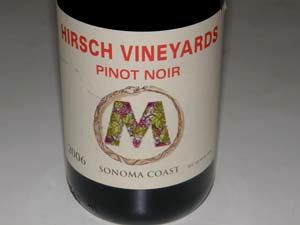 2006 Hirsch Vineyards M Sonoma Coast Pinot Noir 14.9% alc., 448 cases. A middle cuvée of the Hirsch Vineyards site from 22 blocks. · Moderately light purple color in the glass. This wine offers an appealing elegant bent with vivid flavors of fresh red and black fruits, especially cherries, set off by oak spice. The fruit really impacts the mid palate with attention-getting force and lasts forever on the big finish. Very good (+).
2007 Hirsch Vineyards “San Andreas Fault” Sonoma Coast Pinot Noir 14.0% alc.. · Moderately light reddish-purple color in the glass. Aromas of dark red stone and berry fruits with accents of oak, malt and coffee bean. Veers to the redder fruit spectrum with moderate intensity. A refined wine with well-managed oak and tannins, and a lively, grippy finish effusive with cherries and oak. I suspect this wine will continue to improve over the next few years. Very good.
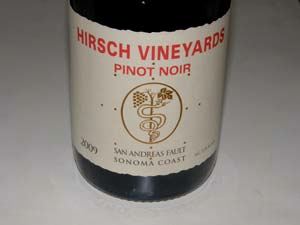 2009 Hirsch Vineyards “San Andreas Fault” Sonoma Coast Pinot Noir 13.7% alc., pH 3.50, TA 0.63, $60. Hirsch Vineyards’ signature Pinot Noir representing the entirety of the vineyard. The fruit is sourced from 21 distinct farming blocks within Hirsch Vineyards. The 2009 vintage was remarkable for its coolness and evenness of weather throughout the growing season. Aged 17 months in 35% new French oak barrels. · Moderately dark reddish-purple color in the glass. The nose evolves slowly in the glass, revealing enticing aromas of berry pie, spice and musk. Delicious essence of black plums and black raspberries with a wild, untamed quality. Relatively delicate on the palate, yet the fruit really pops and coats the mouth for at least a minute on the finish. Seamless, with undeniable charm.
2009 Hirsch Vineyards “West Ridge” Sonoma Coast Pinot Noir 12.9% alc., pH 3.48, TA 0.67, 127 cases, $85. A limited production bottling from three exceptional hilltop blocks on the West Ridge of the Hirsch Vineyard covering 28 acres and divided into 27 farming blocks. This bottling is a selection of the most exceptional barrels from these blocks. Dominated by Mt. Eden clone with a dash of Swan clone. Aged 17 months in 35% new French oak barrels. · Moderate reddish-purple color in the glass. Exotically fruited, with a panoply of fresh, dark berry aromas underlain with scents of oak and underbrush. Pleasing core of dark berry and plum fruit wrapped in moderate tannins with a citric peel acidity in the background. Develops more vivacious fruit over time in the glass indicating cellaring is warranted. Very good.
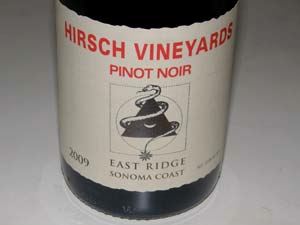 2009 Hirsch Vineyards “East Ridge” Sonoma Coast Pinot Noir 13.8% alc., pH 3.46, TA 0.66, 160 cases, $85. A limited bottling from three of the oldest blocks on the East Ridge of the Hirsch Vineyard comprised of 18 acres and 16 farming blocks. Dominated by Pommard and Mt. Eden clones, this bottling is a selection of the very best barrels from these old blocks. Aged 17 months in 35% new French oak barrels. · Moderately dark reddish-purple color in the glass. Alluring aromas of black cherries and spice. Impressive rush of earth bound black cherry and dark berry fruit on the mid palate, persisting on the long and expressive finish. The mild, sinewy tannins add support and well-honed acidity adds vibrancy. Plenty of character in this wine and in my opinion, the best expression of Hirsch Vineyards Pinot Noir among the wines tasted here. I had some wine left over after tasting the following day, my wife took the wine as a gift to her hairdresser who loves Pinot Noir, but mistakenly left it in the trunk where it stayed for three days. When I retrieved it, five days after opening, it was still fabulous! Built for the long haul and an exceptional Sonoma Coast treasure.
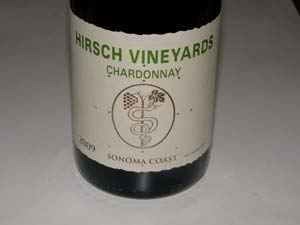 2009 Hirsch Vineyards Sonoma Coast Chardonnay 14.0% alc., pH 3.32, TA 0.63, 725 cases, $75. Four vinification processes: fermented and aged on glass, oak and stainless steel and fermented on stainless steel and aged in oak. All four components were blended and racked to mostly neutral French oak barrels 9 months before bottling. · Medium golden straw color in the glass. Beautifully perfumed with scents of pear, lemon curd, bark, roasted nuts and honey. Delicious spectrum of flavors including pears, baked apples, and creme brulee with a striking aciddriven minerality on the back end. Medium weighted richness with a very smooth texture offering exceptional freshness and refreshing acidity. I have had some stunning Chardonnays from the Sonoma Coast of late and this one may take the cake.
Brewer-Clifton: Treasure Trove of Pinot Noir from LompocBrewer-Clifton is a partnership of two outstanding winemakers, Greg Brewer and Steve Clifton. Clifton arrived in Santa Barbara in 1991 and worked as an assistant winemaker at Rancho Sisquoc Winery, followed by a stint as winemaker at Beckman Vineyards. He hooked up with another young winemaker, Greg Brewer, who became the winemaker at Melville Vineyards and Winery when it was started in 1997. Brewer came to wine from an academic background, having previous worked as a French literature professor at University of California at Santa Barbara. He has taken a number of winemaking leads from Burt Williams whom he greatly admires. The duo decided to dedicate their label to single-vineyard Pinot Noir and Chardonnay at a time in the mid 1990s when many Santa Barbara wineries were concentrating on wines blended from multiple sources. They started with their combined meager savings, without assistance from family or investors, and began producing their wines in 1996 in the unglamorous wine warehouse setting of the Lompoc “Wine Ghetto.” They are still based in Lompoc today. Photo below (Steve left, Greg right).
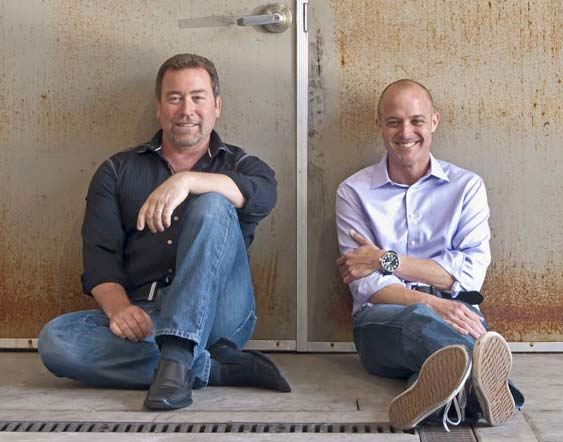 Brewer-Clifton hit pay dirt in 2002 when Robert Parker, Jr., reviewed their wines from the 2001 vintage, and proclaimed the Brewer-Clifton wines to be “the single greatest revelation of my 2001 tastings.” The wines have always been crafted in a full-throttle, ripe, fruit-driven style that Parker espouses and many consumers embrace. The 2010 vintage wines reviewed below show more refinement and complexity. Although alcohols are in the higher range, Brewer is quick to point out that the alcohol percentages listed on the Brewer-Clifton wines are honest, unlike the common practice of many wineries to understate their true alcohol percentage (a 1% margin of error is allowed in wines above 14% alcohol). Vineyard sites have always been carefully chosen and emphasis has always been placed on the vineyard as the ultimate determination of wine quality. A vineyard management team carefully farms several vineyard sources including Mount Carmel and 3-D vineyards. Winemaking is aimed at extracting the most possible flavor. A high percentage of whole cluster is included since the partners believe, “Stems play a vital role in Pinot Noir where we view their involvement as not something added to the equation but simply something that has not been removed.” Fermentation follows a 7- day cold soak and is extended over a two week period with a subsequent 10 day or more extended maceration. The bottles are capped with an attractive red wax seal for Pinot Noir and yellow wax seal for Chardonnay. Both Sta. Rita Hills appellation ($30 -$36) and vineyard-designate wines are offered. The 2010 wines reviewed below were part of the fall 2011 release and are still available. After Parker’s pronouncements in 2002, the wines were highly allocated, but are now more available to the public online, through a mailing list and via some retail distribution. Visit the website at www.brewerclifton.com for more information. A tasting room is open Friday through Sunday at 329 North F Street in Lompoc. Newsletters are offered twice a year.
2009 Brewer-Clifton Clos Pepe Vineyard Sta. Rita Hills Pinot Noir 14.9% alc., 270 cases, $46. · Moderate reddish-purple color in the glass. Closed for business initially, opening slowly to offer subdued cherry fruit over time. Intensely fruity on the mid palate, flush with black cherries encased in supple tannins. The wine presents a charming elegance and easy drink ability, but the flavor profile is linear and the nose lacks interest. Good.
2009 Brewer-Clifton Zotovich Sta. Rita Hills Pinot Noir 14.9% alc., 196 cases, $46. Steve Zotovich owns this vineyard planted in the mid 1990s along Highway 246 between Melville and Foley. · Moderately light reddish-purple color in the glass. Beguiling perfume of red plum sauce, forest floor, spice and the slightest oak becoming more exuberant over time in the glass. Tasty black raspberry and plum fruits with a hint of spice and vanilla. Relatively light in weight and delicate with an appealing softness and charm and some persistence on the finish. Solid the next day from a previously opened and re-corked bottle. Very good.
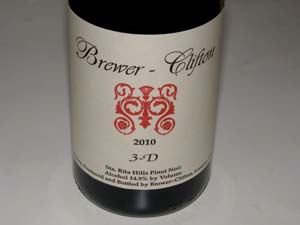 2010 Brewer-Clifton 3-D Sta. Rita Hills Pinot Noir 14.5% alc., 290 cases, $52. Second vintage from a 3-acre vineyard planted to Swan, Pommard and 667 clones in sandy loam. · Moderate reddish-purple hue in the glass. Bright aromas of dark pie berries and plum, spice, slate and oak char. Medium bodied essence of darker Pinot fruits including black plums and black raspberries with a hint of cherry and Asian 5-spice. Complex and layered rather than simply fruity. Admirable crispness and smoothly textured with remarkable persistence on the finish. Very impressive composition and highly recommended.
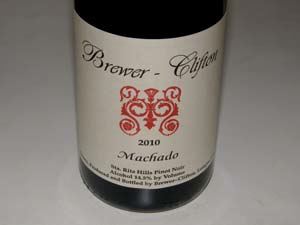 2010 Brewer-Clifton Machado Sta. Rita Hills Pinot Noir 14.5% alc., 290 cases, $46. · Moderate reddish-purple color in the glass. Inviting aromas of plums and dark berry jam. Delicious and majestic in the mouth with flavors that replicate the aromas. The tannins are supportive and the mouth feel is very soft and comforting. Impressive length on the fruit-filled finish. Seamless and beautifully balanced. Still great the next day from a previously opened and re-corked bottle. Like rough sex play: it can raise your interest.
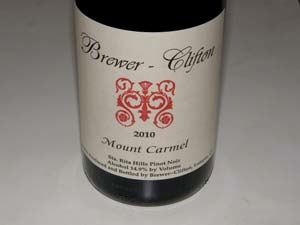 2010 Brewer-Clifton Mount Carmel Sta. Rita Hills Pinot Noir 14.9% alc., 882 cases, $56. Steep slopes of botella clay, diatomite and limestone planted to a quintet of Pinot Noir clones with diverse spacing. · Moderately light reddish-purple color in the glass. The nose is remarkably nuanced, offering scents of fresh raspberry coulis, fragrant tea, dark red rose petals and spice. Rich and sumptuous on the palate, replete with a delicious core of black raspberry and dark red berry fruit that is looking for attention but still encased in tannins. Very impressive mid palate statement that carries over to the big finish that is sure to get better over time. The least approachable wine in the lineup at this time, but this wine has a very bright future.
2010 Brewer-Clifton Mount Carmel Sta. Rita Hills Chardonnay 13.3% alc., 750 cases, $52. · Medium burnished gold color in the glass. Aromas of apple, pear, hazelnut and butter. Soft in the mouth, finishing crisp with enticing flavors of honeyed pear, green apple, kiwi and roasted nuts. Good (+).
Peter Michael Sonoma Coast Pinot NoirAfter more than a decade in the making, Peter Michael has released three Estate Pinot Noirs from the Seaview Estate Vineyard located on the rugged ridges of the true Sonoma Coast. In 1998, the winery acquired a 400- acre parcel on the first ridge inland from the coast above the South Fork of the Gualala River in what is the Fort Ross-Seaview AVA. 30 acres were developed as vineyards, with the remainder preserved as a wildlife corridor. 25 acres were planted in 2006 and an additional 5 acres were added in 2007. The vines are located on moderate to very steep slopes at 1,000 to 1,500 feet above sea level. Soils are a patchwork of rocky alluvial sediments, decomposing volcanic material and clay as is common in this region. All blocks have been planted to carefully selected Burgundian field selections on a mix of rootstocks. Peter Michael Winery made its first Pinot Noir, Le Moulin Rouge, 13 vintages ago with fruit sourced from Pisoni Vineyard and will continue to produce this wine. Peter Michael is the only winery sourcing fruit from this vineyard not to vineyard designate it on the label, naming it instead after the famous Paris nightclub. The three wines offered from the 2009 vintage are from different parts of the vineyard: Ma Danseuse, Le Caprice and Clos due Ciel. Ma Danseuse, which translates as “My Dancer,” is the most feminine of the three and honors Lady Michael as she and Sir Peter met on the dance floor. Le Caprice is from the steepest slopes of the vineyard and the name, translated in French as “The Freak,” honors the rough vineyard terroir. Clos du Ciel, French for “wall enclosed vineyard of the sky,” is a metaphor for the rare microclimate of the vineyard site and is composed of grapes grown on the warmest section of the vineyard. A limited amount of La Caprice Pinot Noir was produced in 2007 and 2008 from Reuling Vineyard in the Sonoma Coast. The winemaker is Nicolas Morlet, who followed his brother and predecessor at Peter Michael, Luc Morlet. Both grew up working on the family domaine, Pierre Morlet & Fils, in Champagne. Nicolas and his brother are fifth generation winegrowers. Nicolas has an impressive winemaking resume in France and received his Bachelor of Science in Enology from the prestigious University of Dijon in Burgundy (Jules Guyot Institute). He first came to California in 1994, worked at Joseph Phelps Vineyards, and joined Peter Michael Winery in 2005. Peter Michael Pinot Noirs are difficult to come by unless you have been a long time member of the winery’s mailing list. You can sign up for the waiting list at www.petermichaelwinery.com. The website is very comprehensive and filled with detailed information. A classy newsletter is published twice yearly (previous issues can be read on the website). The winery is closed to the public, but tours and tastings are available on a limited basis by appointment for active members of the winery’s mailing list (4-8 weeks in advance).
2007 Le Caprice Sonoma Coast Pinot Noir 14.5% alc.. The Reuling Vineyard was planted in 2003 with a field selection from a Grand Cru vineyard in Burgundy. Soils are Goldridge. Indigenous yeast fermentations. Aged 14 months in 30% new French oak barrels and bottled unfined and unfiltered. · Moderately dark reddishpurple color in the glass. Very nicely perfumed with aromas of wild berries, black cherries, spice, cedar and oak. Rich and full-bodied with copious black cherry, black raspberry and black plum fruits, exotically spiced. Soft and smooth on the palate with well-behaved fine-grain tannins and some persistence on the finish. Not as appealing the following day from a previously opened and re-corked bottle. Good (+).
2008 Le Caprice Sonoma Coast Pinot Noir 14.5% alc.. Sourced from Reuling Vineyard. Aged 16 months in 33% new French oak barrels and bottled unfined and unfiltered. · Moderately dark reddish-purple hue in the glass. Muted aromatics with little fruit and demure scent of forest floor and ash. Full-bodied array of lovely, dark red and black fruits which are overwhelmed by firm, sinewy tannins and smoke taint. Decent.
 2009 Le Caprice Seaview Vineyard Sonoma Coast Pinot Noir 14.7% alc.. Released September 1, 2011. 100% naturally fermented using native yeasts. Aged 17 months in 33% new French oak barrels and bottled unfined and unfiltered. · Moderately dark reddish-purple color in the glass. Reserved aromas of dark berry jam and plum reduction sauce with a whiff of oak. The flavors echo the aromas in a rich, bold style exhibiting well-integrated oak, moderate sinewy tannins and some persistence on the fruit-driven finish. More expressive and vivacious the following day from a previously opened and recorked bottle. Very good.
Revisiting Clos Saron: Out of the MainstreamGideon Bienstock, a veteran winemaker, and his spouse Saron Rice have created a small outpost for Pinot Noir in the northern limits of the Sierra Foothills appellation of Northern California. Gideon also is the winemaker for nearby Renaissance Vineyard & Winery and Saron is experienced in viticulture. Together, they set out over twelve years ago to transcend all preconceived notions about Pinot Noir winegrowing in the Sierra Foothills.
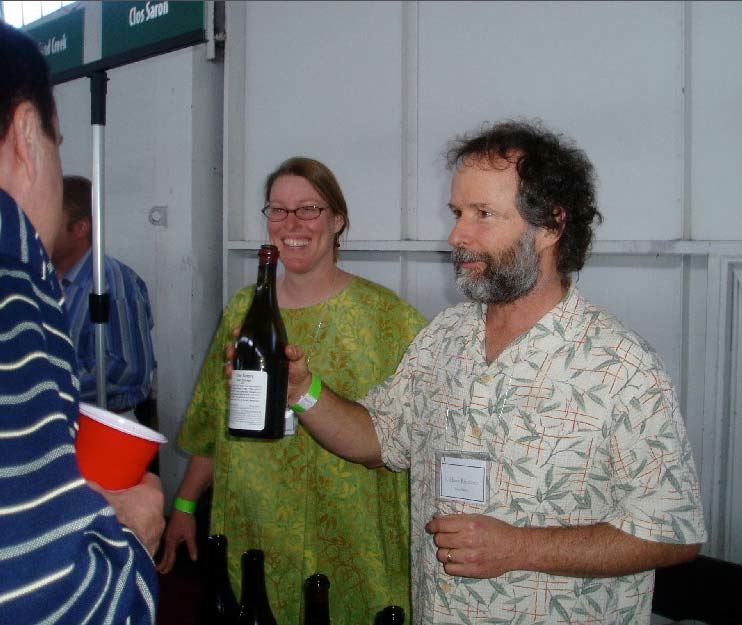 The Sierra Foothills appellation consists of 2.6 million sprawling acres with well over 100 wineries that have had proven success with warmer climate varieties such as Zinfandel, Syrah, Petite Sirah, Cabernet Sauvignon and Sauvignon Blanc. The earliest vines were planted here during the California Gold Rush of the 1800s, and because of the relative isolation of the region from other California growing areas, the vines are protected from phylloxera and other insults. The result is that the Sierra Foothills appellation contains some of California’s oldest producing vines. Pinot Noir is not a variety that comes to mind when you think of the Sierra Foothills, but this appellation has a history with Pinot Noir dating back to the 1880s. The Jackson clones, UCD 1, UCD 9, UCD 16 and UCD 29 evolved from plantings of experimental vineyards in the Sierra Nevada foothills near the town of Jackson in Amador County. The project was abandoned in 1903, but some surviving Pinot Noir vines were discovered in 1963 and, according to John Winthrop Haeger (North American Pinot Noir), the Jackson clones are the earliest documented imports of Pinot Noir still under cultivation in North America, having been imported before 1890. The heart of Clos Saron is the small estate Home Vineyard adjacent the family’s home and tiny winery in the Oregon House Valley of Yuba County. The 2.5-acre vineyard is composed of a potpourri of known and unknown Pinot Noir clones, including Dijon, Pommard, Wente, Swan and suitcase. All vines are own rooted, cordon pruned with a four wire upright trellis. The soil is clay loam on top of volcanic ash, decomposed granite and quartz. The Home Vineyard is located at 1,600 feet and because it is surrounded by hills on three sides, it lies in a particularly cool microclimate by Sierra Foothill standards. Spring frosts are an annual threat. In 2010, late frosts were devastating and 80% of Pinot Noir production was lost. The neighboring Texas Hill Road Vineyard, which Gideon and Saron also farm, lost 100% of its Pinot Noir fruit. Even in the best of years, crop levels are extremely low, with older vines yielding about 1 ton per acre and younger vines less than half that much. Small additional plantings of Pinot Noir are planned so that ultimately Clos Saron will produce 3 to 4 different Pinot Noir bottlings all within a half mile radius of their home, totaling about 400 cases. Winemaking at Clos Saron is very natural with no acid corrections, no racking, and no fining or filtration. The wines are as close to the “natural” winemaking paradigm as any crafted currently in California. The grapes are 100% de-stemmed. Sulfur usage is so minimized that the bottled wines are virtually sulfur free. Gideon notes, “The wines are basically sulfite-free and age on their concentration, balance, tannin and acid rather than on the antiseptic properties of sulfites. The absence of sulfites in the wines is the main cause for their finicky nature, and why they go through various phases of weirdness, depending on when they are opened. This is also the reason for their relaxed, easy development in the glass over time, and in the bottle with years of aging.” The wines tend to have vigorous tannins because of the lean soil and low yields, but in recent years, Gideon has tamed them to some degree. All Pinot Noirs are bottled unfined and unfiltered. I tasted a vertical of Clos Saron Pinot Noir in 2010 (www.princeofpinot.com/article/958/), and decided to revisit two recent vintages to observe the wines’ evolving nature. The winery is open for a tour and tasting by appointment (530-692-1080) and the website is www.clossaron.com. The very small production (less than 100 cases in 2009 and even less in 2010) is offered primarily to a mailing list. The 2009 vintage Home Vineyard Pinot Noir is currently offered.
2007 Clos Saron Home Vineyard Sierra Foothills Pinot Noir 13.4% alc., 82 cases, $45. · Moderately light and red-toned color in the glass. Very seductive aromatic profile featuring scents of crushed black raspberries, leather, rose petals and oak. Delicious flavors of black cherry glaze and black raspberry jam with complimentary exotic spices and vanilla. The fruit really strikes the mid palate with well-mannered grainy tannins and appropriate acidity to bring the fruit to life. Still great later in the day and the following day from a previously opened and re-corked bottle. This wine has several years of life ahead.
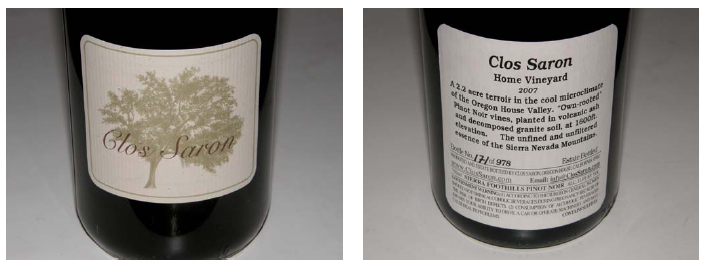
2008 Clos Saron Home Vineyard Sierra Foothills Pinot Noir 13.5% alc., 70 cases, $45. · An inexperienced drinker could easily be frustrated with this wine. Upon opening, there was some reduction followed by notes of pitch, oak, and bay leaf with no fruit evident. On the palate, the mildly astringent tannin overwhelmed the fruit and the wine seemed disjointed and even unappealing with flavors of iodine, tar and green olive. The longer the wine sat in the glass, the better it became with more appealing berry fruit emerging. The following day the wine was re-tasted from a previously opened and re-corked bottle and the transformation was remarkable. The fruit aromas were now clean and vibrant, the core of black raspberry and cherry fruit was vivid and pure and the fruit had emerged from its tannic cloak, lifted by crisp acidity. My family enjoyed the wine with dinner that following day, a perfect match for pot roast. Very good.
Siduri Wines Offers Something for Everyone in 2010Adam and Dianna Lee seem like old hands at Pinot Noir, but it wasn’t that long ago (1994) when they released their first wine. Adam was one of the first young hounds in the Pinot race and one of the first to produce a style of Pinot Noir that was to become the model for many other Pinot Noir specialists to follow including Brian Loring (Loring Wine Company), Andrew Vignello (A.P. Vin) and Michael Browne (Kosta Browne). Adam has refined his winemaking style over the years, now producing wines with more refinement, more subtle and complex flavors, and generally more reined in stylistically. His quote below says it all.
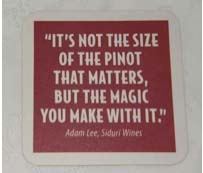 The Lees travel the state of California and Oregon sourcing grapes for their appellation-designated and vineyard-designated Pinot Noirs and produce at least 16 different bottlings, surely unrivaled by any other Pinot Noir specialist on the Pacific Coast. As if that were not enough, Lee also crafts a line of wines including Syrah and other interesting varietals under the Novy Family Winery label. His time management skills are beyond reproach and although several years ago I found some inconsistency due to the sheer number of wines produced, he has mastered the challenge and the Pinot Noirs from his more recent vintages are dependable and unfailingly solid throughout the product lineup. Siduri offers something of interest to everyone. The 2010 appellation-designated wines are drinking beautifully now, and even some of the vineyard-designates have appeal at this early stage because of their soft and silky textures and well-mannered tannins, but for the full flavor experience, drinking is best deferred for another year or two for the vineyard-designated wines. The aromatics, in particular, need more time to evolve in several of the vineyard-designated wines. The 2010 vintage was a challenging one for California vintners. The growing season was cool until heat spikes in August and September in some regions caused grape sugars to jump resulting in higher alcohols. The protracted coolness also led to wines with higher acid levels than usual. Lee crafts his wines in an urban warehouse winery in northwest Santa Rosa. The limited bottlings are sold through a mailing list with some retail distribution of larger production wines. A very informative newsletter keeps mailing list members informed of each group of releases. Tours and tasting are available daily by appointment (707-578-3882 or vino@siduri.com). In 2010, Siduri was named “Sonoma County’s Best Winery” by the San Francisco Chronicle reader’s poll.
2010 Siduri Chehalem Mountains Oregon Pinot Noir 13.1% alc., 1,592 cases, $30, screw cap. 100% de-stemmed, native yeast fermentation. Sourced from 4 vineyards. Blend of Pommard, Wädenswil, 115, 667 and 777. · Light reddish-purple color in the glass. Varied aromas including cherries, sandalwood, brioche, toasted oak, underbrush and leather holster. Tasty red cherry core in a lighter, elegant style that has a slight confected tone. Mild dusty tannins make for easy drinking. An Evesham Wood styled Pinot Noir that is very Oregonian. Good.
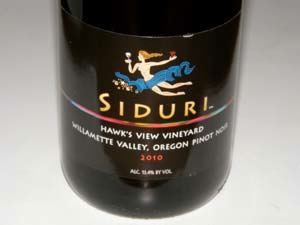 2010 Siduri Hawk’s View Vineyard Willamette Valley Oregon Pinot Noir 13.4% alc., 146 cases, $39, screw cap. · Moderate reddish-purple color in the glass. Intense aromas of black cherries and spice with a subtle floral note. Medium weight essence of black cherries lifted by bright acidity and framed by supple tannins. Very appealing riff of cherries on the pleasing finish. Easily approachable now. Very good.
2010 Siduri Santa Lucia Highlands Pinot Noir 14.5% alc., 1,940 cases, $30, screw cap. · Darkest in color of the appellation wines and displaying the ripest fruit profile. Appealing aromas of plum pudding and blackberry jam are echoed in the flavors with complimentary oak-driven mocha in the background. Medium weight with a soft entry and exit and reserved tannins. Nothing is out of place. Very good.
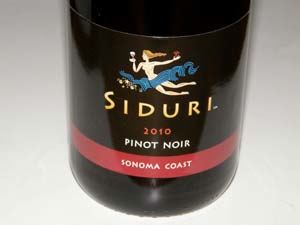 2010 Siduri Sonoma Coast Pinot Noir 14.1% alc.m 496 cases, $30, screw cap. · Moderate reddish-purple color in the glass. Brooding aromas of dark red stone fruits initially, becoming more charming over time in the glass. A nicely composed, balanced, and flavorful medium intensity wine displaying a variety of flavors including pie cherries, dark red berries, sassafras, herbs and tar. Soft in the mouth with restrained tannins and some aromatic persistence on the cherry and citrus toned finish. Very good.
2010 Siduri Sta. Rita Hills Pinot Noir 14.1% alc., 910 cases, $30, screw cap. · Moderately dark reddish-purple color in the glass. The nose is not particularly appealing with very delicate dark red fruits primarily. An earthy wine with a linear display of dark red and black Pinot fruits and a savory mushroom note. Firm tannins, yet soft in the mouth. Slightly more expressive over time in the glass, but still lacks a distinctive crescendo. Check back in 6 to 12 months. Decent.
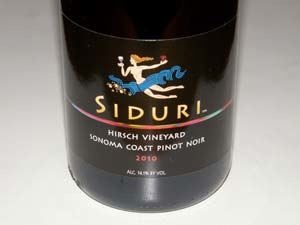 2010 Siduri Hirsch Vineyard Sonoma Coast Pinot Noir 14.1% alc., 96 cases, $50. Ripeness was a challenge at Hirsch Vineyard with lower than normal crop size. Despite this, the resulting wine is quite alluring. · Light reddish-purple color in the glass. The aromatics are stunning with bright aromas of cherry pie glaze, fresh berries, tea leaf and spice. Perfectly ripe fruit offered in an elegant display of delicious dark red cherries and berries with a hint of cherry cola. Silky with perfectly matched tannins. Very appealing and quite approachable now.
2010 Siduri Sonatera Vineyard Sonoma Coast Pinot Noir 14.1% alc., 314 cases, $48, screw cap. Clones 667, 115, and 115. Native and cultured yeast primary fermentation, native MLF. · Moderately dark reddish-purple hue in the glass. Aromas of dark cherry liquor, tea leaf, grass and old cask. Medium bodied and smoothly textured with flavors of black cherries, black raspberries and dried cranberries with a dry herb note in the background. Well-made but just doesn’t grab my full interest. Good.
2010 Siduri Ewald Vineyard Russian River Valley Pinot Noir 14.9% alc., 196 cases, $48. · Dense and darkly colored in the glass. Aromas of ripe plums, mixed berry jam and oak. Intense core of black cherry and blackberry fruit that hits the mid palate with guns blazing. Full-bodied and thick with moderate tannins, and a riff of cherry skin and cirtus peel on the finish. Strap on your jock before attacking this big boy wine. Decent.
2010 Siduri Parsons’ Vineyard Russian River Valley Pinot Noir 14.9% alc., 197 cases, $45. · Dark reddish-purple color in the glass. Nicely perfumed with vivid aromas of black cherries, black raspberries and exotic spices. Big, bold and tasty with a full-on core of black cherry fruit with a sidecar of cola and Hoison sauce. A good spark of acidity keeps the wine juicy and refreshing and this, along with the smooth mouth feel, makes this wine a treat. Very good.
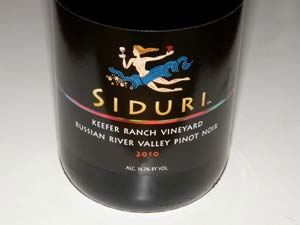 2010 Siduri Keefer Ranch Vineyard Russian River Valley Pinot Noir 14.2% alc., 395 cases, $50. Six clones separately fermented and barrel aged. The ultimate blend was 43% clone 23, 31% clone 114, 19% clone 2A and 7% clone 777. Bottled unfined and unfiltered. · Moderate reddish-purple color in the glass. The nose features redder fruits with a nice whiff of spice and sandalwood. Very typical for this vineyard with a nicely spiced black cherry flavor, good crispness, and fine, dusty tannins. Oak adds a complimentary accent. In two words, very charming.
2010 Siduri Garys’ Vineyard Santa Lucia Highlands Pinot Noir 14.2% alc., 241 cases, $50. · Moderately dark reddish-purple color in the glass. The nose is closed for business with very muted aromas of dark stone fruits and oak. Rather closed, uninspiring and earthy now with a linear display of dark stone fruits in a medium weighted style. Nicely crafted with well-behaved tannins, a good acid spine, and a silk and satin texture, but just isn’t offering much fruit flavor interest at this time. Cellar this one for a good year. Good (+).
2010 Siduri Rosella’s Vineyard Santa Lucia Highlands Pinot Noir 14.1% alc. 582 cases, $50. · Moderately dark reddish-purple color in the glass. This wine is showing the most oak now both on the nose and palate. Aromas of blackberries, boysenberries and coffee. Flavors of plum, dark berries, sassafras and cola with some oak in the background. Very soft in the mouth with notable echo of scent and fruit on the finish. Needs more time to integrate the oak but the core of fruit is gorgeous. Very good.
2010 Siduri Sebastiano Vineyard Russian River Valley Pinot Noir 14.3% alc., 148 cases, $48. · Moderately dark reddish-purple hue in the glass. Aromas of oak, old book, tobacco and delicate red berries. Elegantly styled on the palate with bright flavors of dark red berries and plum with an underpinning of toasted oak. Seamless with pleasing intensity and sleekness, displaying a long, chewy finish. Needs time for complete integration of oak and full enjoyment. Very good.
2010 Siduri Clos Pepe Vineyard Pinot Noir 14.2% alc., 369 cases, $50. · Moderate reddish-purple color in the glass. Rather nondescript nose offering aromas of forest floor and demure dark fruits. Darker fruited on the palate with subtle oak in the background, displaying some very pretty fruit that is still introverted. Nicely crafted and seamless with satisfying finishing acidity, but needs at least a year or two in bottle for full enjoyment. Very good.
2010 Siduri Cargasacchi Vineyard Pinot Noir 14.5% alc., 195 cases, $50. · Moderately light reddish-purple color in the glass. Copious black stone fruits and black berries on the nose with hints of jam on toast, charcoal and oak. Medium-weight core of dark Pinot fruits which are very expressive and attention-getting. Savory and earthy in nature with a subtle smoky, tarry note in the background. Great potential here with further cellaring. Good (+).
Sips of California Pinot Noir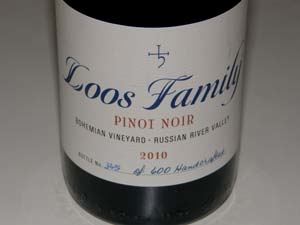 2010 Loos Family Bohemian Vineyard Russian River Valley Pinot Noir 13.5% alc., 50 cases, pH 3.70, TA 0.71, $44. Release date April 2012. Only produced in selected vintages. Vineyard is 7 acres in Freestone planted on Goldridge loam soil. Yields were 2 tons per acre. Clones 115, 667,777 and Pommard. 9-day cold soak with manual punch downs. Wild and inoculated yeasts. Aged in 50% new and 50% neutral French Francois Fréres and Remond Allier oak barrels. Winemakers are Adam Smith and Brad Loos. · Moderate reddish-purple color in the glass. Enticing perfume of red cherries, red plums, hay and dried herbs. Lighter weighted on the palate, but flavorful, featuring red cherries and berries accented by savory herbs. The wine has a unique flavor that distinguishes it from mainstream Pinot Noirs. The tannins are supple and the whole package is well composed. Still solid two days later from a previously opened and re-corked bottle indicating age ability. Very good. Source: brad@loosfamilywinery.com or 408-799-5938.
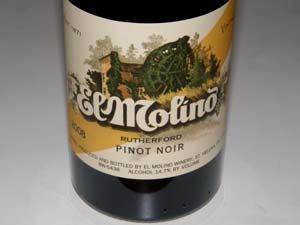 2008 El Molino Rutherford Napa Valley Pinot Noir 14.7% alc., 696 cases, $60. One of the first wineries in Napa Valley, founded in 1871. The label is an original design introduced in 1871 displaying the Bale Mill, or “El Molino.” The grapes are grown at the estate Star Vineyard where the first Pinot Noir block was planted in 1991. The proprietors are Lily and Jon Berlin who are winemaking partners as well. · Moderate reddish-purple color in the glass. A mix of dark red and black berry aromas on the nose is complimented by spice and oak. The core of black raspberry and plum fruit really sings on the palate. The wine is well-endowed with ripe tannins, a silky mouth feel, and impressive fruit presence on the long finish. The fruit pushes the ripe/roasted envelope but never crosses the line. This is a terroir-driven feature, as the vineyard site is considered warm by Pinot Noir standards. Very good. Source: www.elmolinowinery.com and some retail distribution. Star Vineyard below.
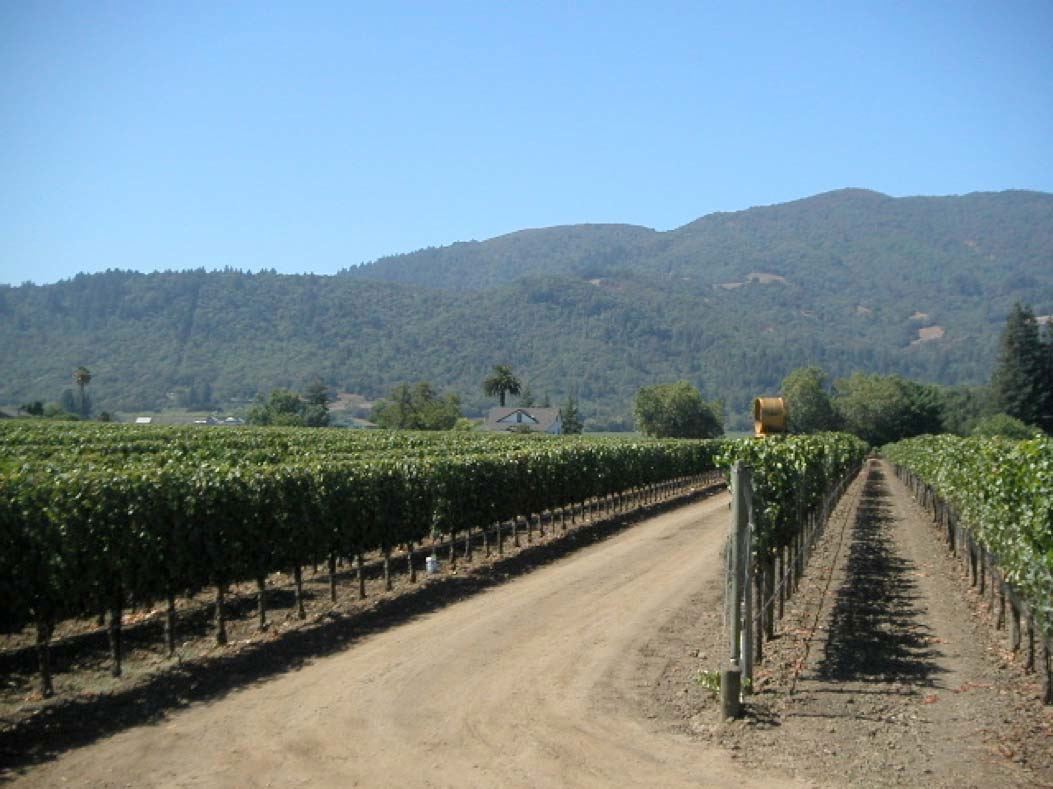
2009 High Flyer Sierra Madre Vineyard Santa Maria Valley Pinot Noir 14.6% alc., 325 cases, $40. · Darkly colored in the glass. Aromas of black fruits, prune, bell pepper, loam, and ash. The flavors of earth-kissed black plums, black raspberries and blackberries push the ripeness envelope. The wine lacks verve and interest. Decent.
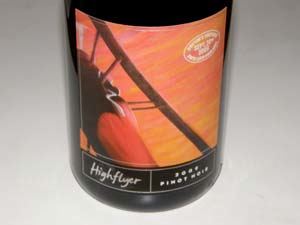 2009 High Flyer Doctor’s Vineyard Santa Lucia Highlands 14.5% alc., 825 cases, $40. · Moderately dark reddish-purple color in the glass. Lovely dark fruit aromas with a touch of cola and spice. Middleweight flavors of black cherries and black raspberries with a complimentary note of sassafras and vanilla. Sleek and very soft in the mouth with restrained, dusty tannins. An appealing wine offering reasonable length on the finish and admirable balance. Very good. Source: www.highflyerwines.com.
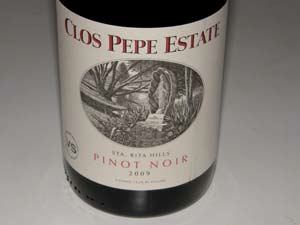 2009 Clos Pepe Vigneron Select Sta. Rita Hills Pinot Noir 14.2% alc., $64 (sold out). · Moderate reddish-purple color in the glass. Lovely aromas of fresh black cherries with cardamom spice and a hint of toasty oak. Modestly intense flavors of cherries, cranberries and dark red raspberries with a savory note of mushrooms, herbs and a hint of oak. This wine has understated charm with a soft texture, mild tannins and a good cut of acidity on the slightly tart finish. Has the balance to continue to improve in the cellar. Still fine the next day from a previously opened and re-corked bottle. Very good. Source: www.clospepe.com. The 2010 vintage is available now.
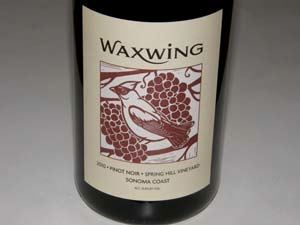 2010 Waxwing Spring Hill Vineyard Sonoma Coast Pinot Noir 14.8% alc., 75 cases, $33. Clones are Pommard, 115 and 777. Aged 12 months in onceused French oak barrels. A heat spike just before picking drove the sugar levels up. The wine is crafted in a shared boutique winery space in San Carlos, California. · Moderately light reddish-purple color in the glass. Extroverted nose displaying aromas of fresh dark red berries with a hint of sandalwood and spice. Tasty core of mixed berries with noticeable oak spice and vanilla. Elegant in style, but packed with flavor which lingers on the long finish. A charming wine that needs more time in the cellar to integrate its oak. Very good. Source: www.waxwingwines.com.
2010 Masút Vineyard & Winery Estate Vineyard Mendocino Pinot Noir 14.5% alc., pH 3.56, TA 0.63, 700 cases, $40. From a 23-acre hillside vineyard planted in 1997. Whole berry de-stemmed into open top fermenters. Both native and proprietary yeasts were used during the 16-day fermentation. The wine was aged 11 months in 50% new French oak barrels. · Moderate reddish-purple color in the glass. Strong aromas of oakdriven coffee mocha with no fruit contribution. Lovely and pleasing on the palate, featuring perfectly ripe and luscious black cherry fruit, but the fruit is buried in oak-driven flavors of char and coffee mocha. About the same the following day from a previously opened and re-corked bottle. Only time will tell if enough of the oak will integrate to allow the fruit to really shine. Good. Source www.masut.com and retail distribution in multiple states.
2010 Longoria Lovely Rita Sta. Rita Hills Pinot Noir 13.8% alc., pH 3.66, TA 0.53, 360 cases, $32. A blend of 94% Fe Ciega Vineyard and 6% Bien Nacido Vineyard. Fermented in both the Ganimedes fermenter and open top fermenter. Aged 11 months in 20% new French oak barrels. · Medium reddish-purple color in the glass. Complex aromatics featuring scents of dark red raspberries and cranberries, spice, tea leaf, wet leaves and potpourri. Lighter weighted, but charming dark red berry flavors with supporting toasty oak. A wellrounded offering with nicely proportioned tannins and easy drink ability. Ready to drink now, but will last a few years. Good (+).
2009 Longoria Fe Ciega Vineyard Sta. Rita Hills Pinot Noir 14.2% alc., pH 3.58, TA 0.60, 605 cases, $48. 100% de-stemmed and crushed into small open top fermenters. 3-day cold soak, inoculated, average fermentation lasted 12 days. Aged 15 months in 30% new French oak barrels. · Moderately dark reddish-purple color in the glass. The nose features deep purple fruits with noticeable oak. Rugged and masculine in nature with a full offering of earthy black plum, black currant and blackberry fruit encased in flamboyant tannins and accented by plenty of oak. Much better the following day from a previously opened and re-corked bottle showing softer tannins and more vivacious fruit, but still significantly oaked. There is plenty of upside in this wine that needs cellaring for at least a few years to integrate the oak and tannins. Decant if you must open now. This wine has such a distinctive character each vintage that I am sure I could pick it out blind from a lineup. It definitely reflects its terroir. Very good. Source: www.longoriawine.com.
2010 McNeil & Sons Redding Ranch Vineyard Marin County Pinot Noir 13.28% alc., 100 cases, $60. Clones 667, 777 and Pommard. Yield .75 tons per acre. Named after the “McNeil & Sons” turn-of-the-century butcher shop that still stands on the Nicasio town square in Marin County. The vineyard is situated at 1,200 feet elevation near the windswept crest of Mount Shroyer, a very cool, coastal site. Chalone Wine Group planted this 20-acres of high-density Pommard and Dijon clones in the spring of 2000. Well-drained, rocky soils. 33% whole cluster, native yeast fermentations, aged in 25% new, 50% once-used and 25% neutral French oak barrels. Unfined and unfiltered. Winemaker is Jon Grant (Couloir). · Moderately light reddishpurple color in the glass. The nose unfolds slowly in the glass, reaching an interesting array of scents including cherries, spice and bramble. Medium weighted and elegant, with layers of flavor including dark red cherry mash, blueberries, tea, stem and Asian 5-spice. Exotic and distinctive, with well-mannered tannins and admirable length. A very interesting wine that veers from the usual California paradigm. Very good. Source: www.mcneilwines.com and The Butcher Shop, Nicasio, California.
Sips of Oregon Pinot Noir
Montalieu is a French ex-patriot who grew up on the Caribbean Island of Guadaloupe, but spent summers in his family’s home in Bordeaux, where he learned to grow grapes and make wine. He has many projects in Oregon including his own label, Soléna, with his wife, Danielle Andrus Montalieu whose father, Gary Andrus, started Pine Ridge Winery when she was 10 years old, and who later founded Archery Summit in Oregon. The Montalieus founded Grand Cru Estates in the Yamhill-Carlton District, a winery where Soléna is crafted and members are allowed access to premium fruit and work one-on-one with the Montalieu and winemaker Tony rynders to craft their own Pinot Noir. The Montalieus are also part owners of NW Wine Company in McMinnville where Laurent crafts wine for several labels, and part owners of Hyland Vineyard and Estates. The Kudos wines are crafted at NW Wine Company. The brand has no website and the wines are sold through retail distribution channels including Whole Foods Markets. The wines are of very high quality considering the reasonably prices. They undergo a short period of barrel aging, are released early, and are intended for drinking upon release.
2010 Kudos Willamette Valley Oregon Pinot Noir 13.5% alc., pH 3.51, TA 0.62, 10,000 cases, $15. · Moderately light reddish-purple color in the glass. Pleasing aromas of strawberries and red cherries with grassy herbs and oak spice. Relatively light red cherry and red raspberry fruit flavors with an underpinning of savory herbs. Crisp and tasty, with mild tannins and a lively acid backbone leading to an uplifting finish. A solid daily drinker. Good (+).
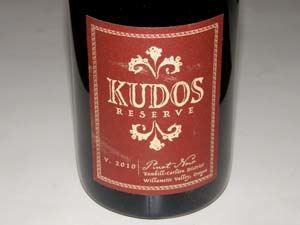 2010 Kudos Reserve Yamhill-Carlton District Willamette Valley Oregon Pinot Noir 13.8% alc., pH 3.59, TA 0.54, 1,560 cases, $20. Aged 7 months in 15% new French oak barrels. A blend of vineyards. · Moderately dark reddish-purple color in the glass. Aromas of dark fruits, earth and oak. A middleweight offering of tasty black cherry, black raspberry and plum fruits with a very slight complimentary accent of oak char. The wine displays an earth and mineral foundation typical of this region. The fruit core makes an impression, the slightly grainy tannins are reined in, the mouth feel is satiny and seamless, and the wine finishes with bright acidity. Very good.
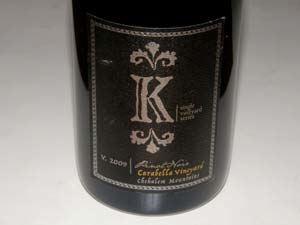 2009 Kudos Carabella Vineyard Chehalem Mountains Willamette Valley Oregon Pinot Noir 14.2% alc., pH 3.51, TA 0.59, 317 cases, $30. Aged 8 months in 22% new French oak barrels. · Moderately light reddish-purple color in the glass. Brooding aromas of dark red stone fruits, spice and oak. Impressive mid palate explosion of perfectly ripe red fruits wrapped in mild dry tannins, finishing with a striking intensity of cherry fruit. Very smooth in the mouth, with an ephemeral finishing tone. Very enjoyable wine at this price point. Very good (+).
2010 Kudos Zena Crown Vineyard Eola-Amity Hills Willamette Valley Oregon Pinot Noir 13.7% alc., $30. · Moderately light reddish-purple hue in the glass. The nose is oak-driven with the scent of brewed coffee. On the palate the core of dark red and purple fruit is moderately dense and intense and offers an amazing persistence on the huge finish. There is more oak on board than I like, but this should moderate over time in the cellar. Very good.
2009 Kudos Zena Crown Vineyard Eola-Amity Hills Willamette Valley Oregon Pinot Noir 13.8% alc., $30. · Moderately light reddish-purple color in the glass. Demure cherry aromas with prominent scents of hay, underbrush and oak. Herb-inflected strawberry and cherry flavors with an earthy oak background, mild tannins, decent acidity and a pleasing cherry finish. Soft, elegant and refined. Lacks the luscious fruit and structure of the 2010 bottling. Good (+).
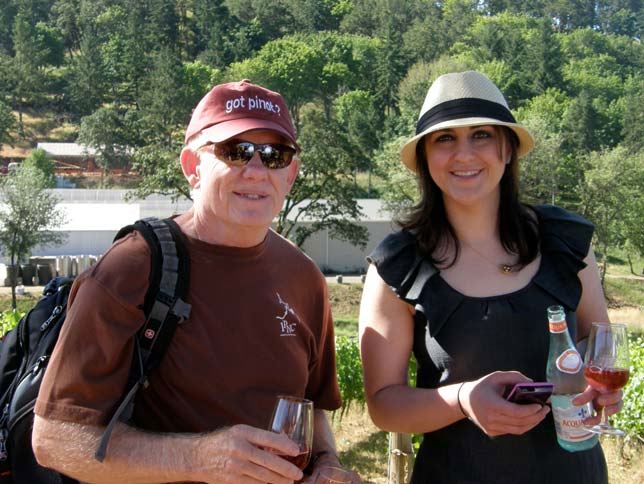 The wines reviewed are all 100% de-stemmed and fermented with indigenous yeast in stainless steel tanks. The wines were racked twice before bottling without fining. 2009 Maysara Jamsheed McMinnville Oregon Pinot
 2009 Maysara Jamsheed McMinnville Oregon Pinot Noir 13.7% alc., 8,722 cases, $25, screw cap. Jamsheed was an ancient Persian King able to peer into his wine chalice and glimpse his entire kingdom. Dijon and Pommard clone vines planted on a variety of soil tyhpes and elevations within the Momtazi Vineyard. Aged 11.5 months in 8% new French oak barrels. · Moderately light reddish-purple hue in the glass. Bright aromas of fresh pie cherries, strawberries, red rose petals, bay leaf and oak. Flavors of dark cherries, ripe strawberries and a hint of plum, anise and oak, supported by supple tannins and bright acidity. Soft in the mouth and easy to drink now. Very good (-).
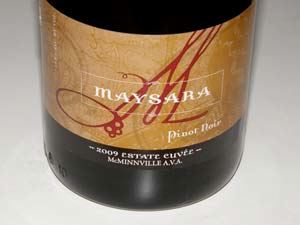 2009 Maysara Estate Cuvée McMinnville Oregon Pinot Noir 13.8% alc., 919 cases, $32, screw cap. Clones 113, 114, 667, 777 and Pommard. Aged 12 months in 30% new French oak barrels. · Moderately light reddish-purple color in the glass. Very appealing aromas evolve with conviction on the nose which shows a perfume of dark red cherries and berries, dried herbs and complimentary oak. Mid weight flavors of perfectly ripe Bing cherries and raspberries wrapped in ripe fruit tannins with some persistence on the juicy finish. A refined and rounded wine that is very enjoyable.
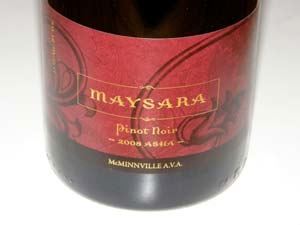 2008 Maysara Estate Asha McMinnville Oregon Pinot Noir 13.5% alc., 580 cases, $39, screw cap. Aged 22 months in 40% new French oak barrels. · Medium reddish-purple color in the glass. Complex aromatic profile offering scents of dark cherries and berries, rose hips tea, potpourri and dark chocolate. Discreetly concentrated core of very ripe cherries, berries and plums with an undertone of brown spices and sassafras exhibiting a long, hi-strung, citric-laced finish. Should evolve beautifully over the next 5 to 10 years. Very good (+).
The current proprietors, who had backgrounds in the wine and hospitality industry, purchased Youngberg Hill in 2003 and completely renovated the entire estate including viticulture practices, winemaking, the tasting room and hospitality. The winery’s tasting room is open daily from 11:00 AM to 5:00 PM. The estate is a popular site for weddings. Visit the very informative website at www.youngberghill.com for more information and to purchase wines.
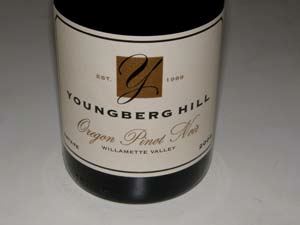 2009 Youngberg Hill Estate Willamette Valley Oregon Pinot Noir 13.9% alc., pH 3.50, 412 cases, $20, screw cap. Clones are 40% Wädenswil and 60% Pommard. · Moderately light reddish-purple color in the glass. Aromas of wild red berries, cherries, red licorice, exotic wood and cut grass. Light bodied but with a flavorful core of slightly confected red fruits including cranberries and cherries with a hint of savory herbs. The finish offers a bright cut of acidity. A nicely composed wine that can stand on its on as an aperitif or work beautifully at the dinner table. Good (+).
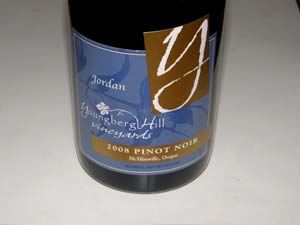 2008 Youngberg Hill Vineyards Natasha McMinnville Oregon Pinot Noir 14.0% alc., pH 3.60, 370 cases, $30. The Natasha’s Block sits on 6.6 acres facing southeast and receives the maximum amount of sunlight. 50% Wädenswil and 60% Pommard clones. · Moderate reddish-purple color in the glass. A deeply perfumed nose offering a thrust of dark berry aromas with hints of dried herbs, walnuts and cut flowers. Middleweight dark berry flavors with riffs of savory herbs and anise, making an impression on the mid palate and lingering with intensity on the long finish. Prominent tannins are well balanced by good acidity. Like so many Pinot Noirs from the superb 2008 vintage in Oregon, this wine needs several years in the cellar to allow full integration of tannins and complete flavor development. This was demonstrated when a previously opened and re-corked bottle was tasted two days later and showed luscious fruit flavors with softer tannins and a velvety mouth feel.
On the Pinot Event Trail
Pinot Days Southern California
|
